The Zambia Air Force's strategic objective is to defend and support the nation as mandated by the Constitution of the Republic of Zambia. Peace is a vital aspect of political stability and sovereignty, allowing for economic and social development. The Zambia Air Force uses military might to sustain and maintain peace, allowing Our Nation to act in its own interests, including political, economic, ideological, or cultural objectives. As your Commander-in-Chief, I urge all citizens to remain united and patriotic as we uplift your living standards through economic recovery, sustainable debt management, and investment strategies that bring meaningful value to the people. Climate changes is a threat to food security and stability of livelihoods. Therefore, I am proud to announce the expanded role to the Defence Forces to combat climate change through innovative agricultural support. The capabilities extend beyond traditional defence. This expanded role aligns perfectly with commitment to strategies that bring value to the people. By supporting a robust agricultural sector, the Defence Force helps to ensure food security and economic prosperity for all Zambians. The Air force remains resolute in its mission and reaffirms its unwavering commitment to help overcome the challenges posed by climate change as we build a more resilient Zambia. May God bless Zambia.

The Minister of Defence Hon. Ambrose L Lufuma MP.
Peace is the absence of violence – direct or indirect, manifest or posed as a threat. Peace is often viewed as a temporary and fleeting condition. Peace is most often the result of a balance of power and agreed spheres of interest. ZAF has also increasingly participated in the promotion of national, regional and global security and peace efforts as a response to the ever changing threat. Terrorism is one of the global threats that require us to position ourselves in order to deter and manage this threat.
It is for this reason that our participation in global peace efforts have taken on a new dimension in that ZAF has evolved from merely contributing troops as force protection and military observers to deploying to the United Nations and Sub Regions and around the world through bilateral co-operation with Defence Forces from other countries within and beyond the African continent.
Lieutenant General Oscar M A Nyoni
Strategy
Zambia Air Force strategy is archived by coordinating the development, deployment and employment of air power assets to achieve our National security objectives. Air power with its intrinsic characteristics of speed, elevation and reach provides tremendous strategic options. These strategies are then prosecuted by Zambia Air Force campaigns and missions which comprise of a variety of air operations. The Zambia Air Force strategy is developed at the Air HQ, the operational art for employing air power is conducted through our Commands listed below For successful execution of our operations;
- Central Air Defence Command
- Northern Air Defence Command
- Southern Air Defence Command
- Strike Command
- Tactical Air Mobility Command
- Logistics Command
- Training Command
Roles
ZAMBIA AIR FORCE ROLES depend on the nature of the threat, resources available and the unique nature of the campaign and are as follows:
- Defence of national territories and assets, against attacks from air both during peace and war.
- Deterring an aggressor from carrying out hostile acts and if deterrence fails to mount an eff effective response.
- During operations, achieve control of the air to the required degree for the Zambia Army to engage enemy ground forces.
- to provide full freedom of action to the air and surface forces.
- Applying direct pressure on the enemy’s power of resistance by attacking his crucial centres of gravity.
- Synergy in the combat potential of air power with the Zambia Army to achieve joint military aims and objectives.
Roles Cont'd
- Deploying and employing forces to protect and project the national interests in any out of country contingency operation.
- Assisting the government in disaster management or humanitarian relief tasks.
- Executing counter terrorism and counter insurgency operations.
- Fulfilling international commitments requiring air power assets, consistent with our national policies and interests.
Consequently, the damage sustained by friendly forces and facilities would also be reduced. This then should guide the force structuring and related operational art. Our emphasis an an Airforce is on causing maximum attrition by means of an active air defence network.
The Deputy Air Force Commander

& Chief of Air Staff
Major General Arthur Kalaluka psc MSc (DS) DFM
Airforce Capabililties
Although air power is capable of independently achieving desired political objectives, it works most effectively when integrated with other components of military power. Through air power’s flexibility and the speed with which it can reach the battlespace, it provides vital projection and sustainment, offering significant military advantage. The full spectrum approach to national power employs diplomatic, economic and military instruments of national power, all underpinned by information.
Effective cross-environment integration depends on mutual trust and understanding, built on well-established bilateral cooperation between single Services. Large, complex, multinational air operations require a comprehensive command and control capability. The ability to deliver each of the four air power roles is dependent on critical enablers: base; sustain; connect; and protect.
The employment of air power directly contributes to Zambia Defence Force Tasks. Various basing options enable the delivery of rapid effect across the globe; air logistics enable the sustainment of operations; command, control, computing and communication capabilities enable connectivity; and force protection capabilities enable the protection of forces at home and overseas.
Operations
Zambia Air Force Operations are becoming more efficient and successful, as they are being sustained and supported by the following air and ground activities for combat enabling;
- Combat Enabling Air Operations.
- Tactical Air Mobility Operations.
- Surveillance and Reconnaissance.
- Remotely Piloted Aircraft (RPA) by Elbit Hermes AC.
- Search and Rescue (SAR).
- Testing, Evaluation and Research and Development.
- Combat Enabling Ground Operations.
- Base Maintenance & Engineering of New Infrastrusture such as AHQ Runway Rehabilitation.
- Integrated Logistics, Supply & Procurement activities.
- Passive Air Defence (PAD).
- Ground Defence (GD).
- Special Forces (SF) Operations Airbourne Parashute.
- Training Schools for Professional Military & Civil Education.
- Administration, Personnel Welfare & Recreation Facilities.
Joint Operations
Joint operations have the potential to be extremely effective because the various capabilities across the single Services complement the strengths and compensate the limitations in each, thus creating powerful synergies. However, to maximise their effectiveness, they need to be efficiently integrated.
The Zambia Air Force focuses heavily on air-land integration. During recent operations with the Zambia Army which gave us sufficient knowlegde and experience for complex operations along, and across, more than one domain.
This is particularly relevant in the complex contemporary operating environment, where operations are likely to require effective integration between the land & air domains, all are underpinned by information needed to Command and Control through a shared common operational digital picture.
Zambia Air Force Air Power Platforms
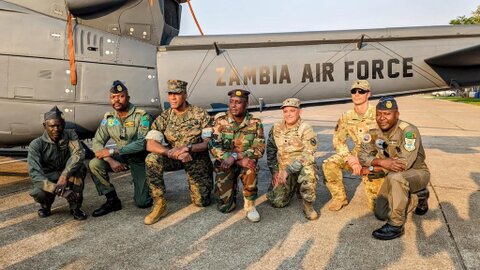
UNITED STATES ANNOUNCES DONATION OF HELICOPTERS TO ZAMBIA AIR FORCE
LUSAKA – On September 11, the United States announced an $80 million (1.6 billion Kwacha) grant to Zambia that will supply four Bell 412EP helicopters to the Zambia Air Force with three years of service, parts, and training for the helicopters. During a press conference, Zambia Air Force Major General Oscar Nyoni thanked the U.S. government for the donation, noting that this grant will enable the Zambia Air Force to better support the domestic needs of Zambia, regional security, and UN peacekeeping missions abroad.
Commander of U.S. Africa Command General Michael Langley made the announcement at the Africa Senior Enlisted Leaders Conference (ASELC), which the United States and Zambia co-hosted from September 10-13. This annual conference convened senior enlisted leaders from approximately 30 African countries to discuss mutual challenges and opportunities, including crisis response, rule of law, protecting natural resources, addressing instability, and strengthening security cooperation. Zambia is the first African nation to host the ASELC.
Commander of U.S. Africa Command General Michael Langley made the announcement at the Africa Senior Enlisted Leaders Conference (ASELC), which the United States and Zambia co-hosted from September 10-13. This annual conference convened senior enlisted leaders from approximately 30 African countries to discuss mutual challenges and opportunities, including crisis response, rule of law, protecting natural resources, addressing instability, and strengthening security cooperation. Zambia is the first African nation to host the ASELC.
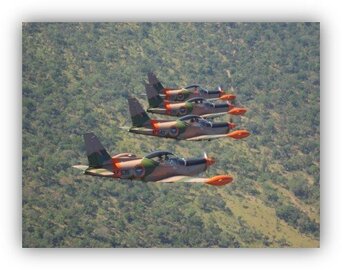
Zambia Air Force Trainer Aircraft - SIAI-Marchetti SF.260
The SIAI-Marchetti SF.260 (now Leonardo SF-260) is an Italian light aircraft which has been commonly marketed as a military trainer and aerobatics aircraft.
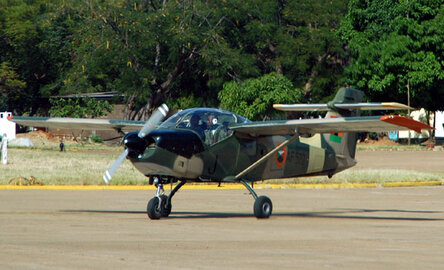
Zambia Air Force Trainer Aircraft - Saab MFI-15 Safari
Saab MFI-15 Safari, also known as the Saab MFI-17 Supporter, is a propeller-powered basic trainer aircraft used by several air forces.

Zambia Air Force Trainer & Utility Aircraft -The Bell 206
The Bell 206 is a family of two-bladed, single- and twin-engined helicopters, manufactured by Bell Helicopter at its Mirabel, Quebec, plant.
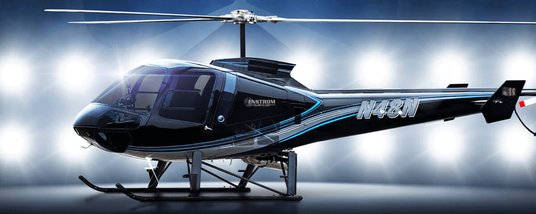
Zambia Air Force Trainer & Utility Aircraft - Enstrom 480B
The Enstrom Turbine 480B-G; Developed to US Army New Training Helicopter (NTH) requirements, this aircraft is known for its reputation for safety, stability, comfort, and value. The 480B combines power and weight with light agility at the controls. Experienced pilots attest to its unparalleled stability and solid craftsmanship. With the fewest number of retirement items and no airframe life limit, our 480Bs have lower direct operating costs and spend less time on the ground.

Zambia Air Force Trainer & Utility Aircraft - Enstrom 480B - Features
Enstrom Helicopters are well-suited for military pilot training, law enforcement and emergency medical use, and commercial and agriculture markets. In addition, Enstrom builds a fun helicopter to fly for the private pilot. All Enstroms are proudly made in the USA with domestic parts and labor.
Features are as follows; Energy-absorbing landing gear, Five-seat cabin configuration with litter carrying capabilities,
Custom paint designs with virtually unlimited color schemes
Powerful Rolls-Royce 250 C20w turbine engine, 240º pilot visibility with chin and overhead windows, High skids for police, agricultural spray, and military equipment, High-inertia rotor system, which greatly benefits autorotation capability,
Unblocked tail rotor, providing excellent control in high winds from any angle, Good Hot and High Performance and Low maintenance with excellent parts availability.
Features are as follows; Energy-absorbing landing gear, Five-seat cabin configuration with litter carrying capabilities,
Custom paint designs with virtually unlimited color schemes
Powerful Rolls-Royce 250 C20w turbine engine, 240º pilot visibility with chin and overhead windows, High skids for police, agricultural spray, and military equipment, High-inertia rotor system, which greatly benefits autorotation capability,
Unblocked tail rotor, providing excellent control in high winds from any angle, Good Hot and High Performance and Low maintenance with excellent parts availability.
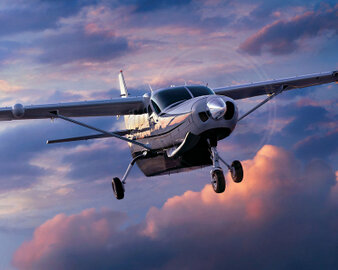
Zambia Air Force Trainer & Utility Aircraft - The CESSNA CARAVAN
The CESSNA CARAVAN aircraft is known for its rugged utility and flexibility. With its powerful turboprop engine, the Caravan aircraft delivers the rare combination of high performance, low operating costs and ability to adapt to a wide variety of missions
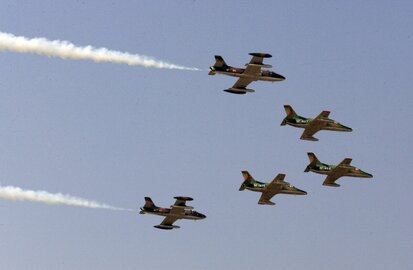
Zambia Air Force Trainer & Light Attack Aircraft - The Aermacchi or Macchi MB-326
The Aermacchi or Macchi MB-326 is a light military jet trainer designed in Italy. Originally conceived as a two-seat trainer, there have also been single and two-seat light attack versions produced. It is one of the most commercially successful aircraft of its type, being bought by more than 10 countries and produced under licence in Australia, Brazil and South Africa. It set many category records, including an altitude record of 56,807 ft (17,315 m) on 18 March 1966. More than 800 MB-326s were constructed between 1961–1975
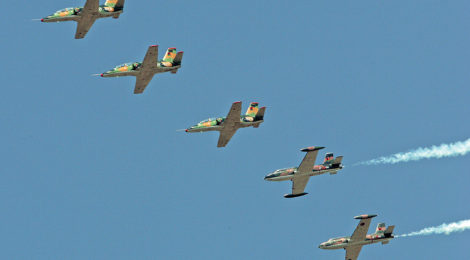
Zambia Air Force Trainer Aircraft - The Karakorum-8 or K-8
The Hongdu JL-8 (Nanchang JL-8), also known as the Karakorum-8 or K-8 for short, is a two-seat intermediate jet trainer and a light attack aircraft designed in the People's Republic of China by China Nanchang Aircraft Manufacturing Corporation. Pakistan is also the co-Partner of this project.

Zambia Air Force (Lead In Fighter Trainer) Advanced Aircraft - The L-15 Falcon
The Hongdu JL-10 also known as the L-15 Falcon (猎鹰) is a supersonic advanced jet trainer and light combat aircraft developed by Nanchang-based Hongdu Aviation Industry Corporation (HAIC) to lead-in fighter trainer (LIFT) requirements, as well as next-generation training and light combat.
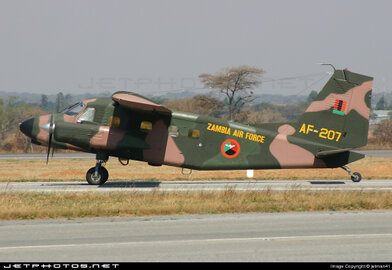
Zambia Air Force Transport Aircraft - Dornier Do 28
The type designation Dornier Do 28 comprises two different twin-engine STOL utility aircraft, manufactured by Dornier Flugzeugbau GmbH. The Do 28 series consists of the fundamentally different Do 28 A/B and Do 28 D Skyservant
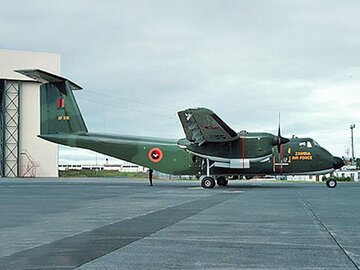
Zambia Air Force Transport Aircraft - The de Havilland Canada DHC-5 Buffalo
The de Havilland Canada DHC-5 Buffalo is a short takeoff and landing (STOL) utility transport turboprop aircraft developed from the earlier piston-powered DHC-4 Caribou. The aircraft has extraordinary STOL performance and is able to take off in distances much shorter than even most light aircraft can manage.
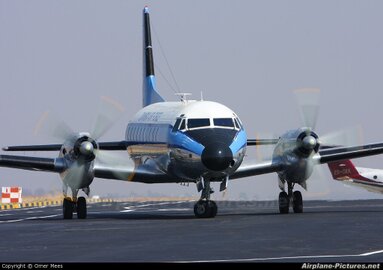
Zambia Air Force Transport Aircraft - The Hawker Siddeley HS 748
The Hawker Siddeley HS 748 is a medium-sized turboprop airliner originally designed and initially produced by the British aircraft manufacturer Avro. It was the last aircraft to be developed by Avro prior to its dissolution.
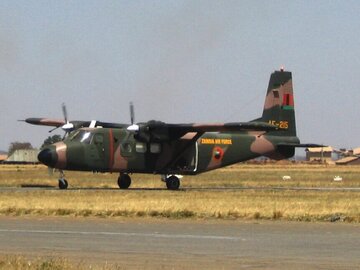
Zambia Air Force Transport Aircraft - The Harbin Y-12
The Harbin Y-12 (Chinese: 运-12; pinyin: Yùn-12) is a high wing twin-engine turboprop utility aircraft built by Harbin Aircraft Industry Group (HAIG). Harbin Y-12 (II) has a maximum takeoff weight of 5,700 kg (12,600 lb) with seating for 17 passengers and two crew. The aircraft is operated as a light commuter and transport aircraft.
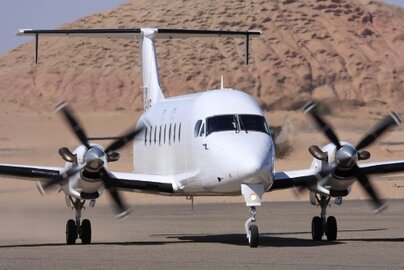
Zambia Air Force Transport Aircraft - BEECHCRAFT 1900D
The BEECHCRAFT 1900D is the 19-passengers world-class turbo-prop airliner, one of the most efficient and flexible regional air transport solutions. Good performance in hot and high conditions. Excellent speed and operating altitudes. Pressurized and comfortable stand-up cabin. High reliability, low operating and maintenance costs.
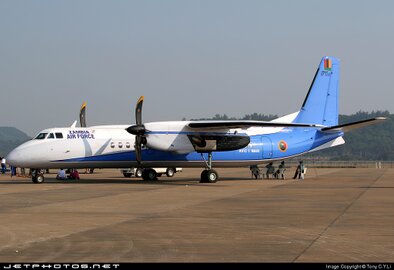
Zambia Air Force Transport Aircraft - The Xian MA60
The Xian MA60 (新舟60, Xīnzhōu liùshí, "Modern Ark 60") is a turboprop-powered airliner produced by China's Xi'an Aircraft Industrial Corporation under the Aviation Industry Corporation of China (AVIC). The MA60 is a stretched version of the Xian Y7-200A, which was produced based on the An-24 to operate in rugged conditions with limited ground support and has short take-off and landing (STOL) capability.
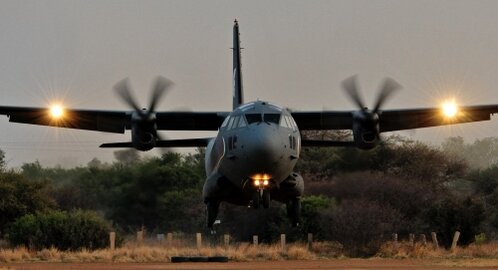
Zambia Air Force Transport Aircraft -The Alenia C-27J Spartan
The Alenia C-27J Spartan is a military transport aircraft developed and manufactured by Leonardo's Aircraft Division (formerly Alenia Aermacchi until 2016). It is an advanced derivative of Alenia Aeronautica's earlier G.222 (C-27A Spartan in U.S. service), equipped with the engines and various other systems also used on the larger Lockheed Martin C-130J Super Hercules.
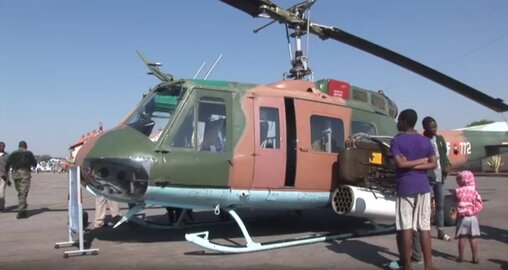
Zambia Air Force Utility Aircraft -The Bell 205A & The Bell 212 – Military utility transport helicopter.
The Bell 204 and 205 are the civilian versions of the UH-1 Iroquois single-engine military helicopter of the Huey family of helicopters. They are type-certificated in the transport category and are used in a wide variety of applications, including crop dusting, cargo lifting and aerial firefighting.
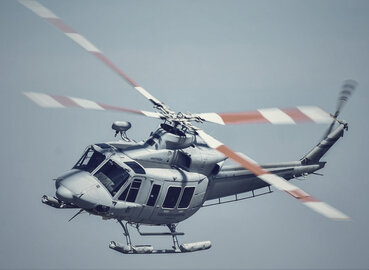
Zambia Air Force Utility Aircraft - Bell / Agusta Bell 412
The Bell 412 is a utility helicopter of the Huey family manufactured by Bell Helicopter. It is a development of the Bell 212, with the major difference being the composite four-blade main rotor.
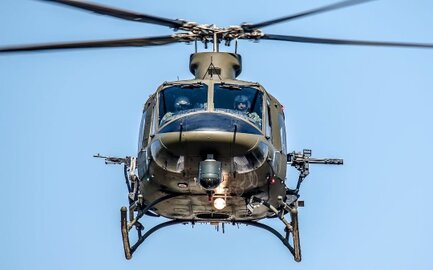
Zambia Air Force Utility Aircraft - Bell / Agusta Bell 412 Cont'd
The 412 structure incorporates many safety features, including a rupture-resistant fuel system; jettisonable crew doors; sturdy construction and bulkheads for roll-over protection; wire strike protection on the nose; dual redundant electrical, hydraulic and fuel systems; dual digital flight control and a rugged high-reliability twin pack engine. It is also fitted with rotors and controls system, transmission drive systems, communication and navigation system, hydraulic and fuel systems and dual digital flight control.

Zambia Air Force Utility Aircraft - The Harbin Z-9
The Harbin Z-9 (NATO reporting name "Haitun", Chinese: 海豚 for Dolphin is a Chinese military utility helicopter with civilian variants. It is a licensed variant of the French Eurocopter AS365 Dauphin, and is manufactured by Harbin Aircraft Manufacturing Corporation.

Zambia Air Force Utility Aircraft - The Mil Mi-17
The Mil Mi-17 (NATO reporting name: Hip) was a Soviet and current Russian military helicopter in production at two factories in Kazan and Ulan-Ude. It is known as the Mi-8M series in Russian service. The helicopter is mostly used as medium twin-turbine transport helicopter, as well as an armed gunship version.
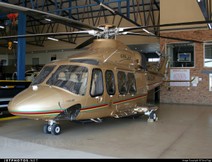
Zambia Air Force VVIP Aircraft - The AgustaWestland AW139
The AgustaWestland AW139 is a 15-seat medium-sized twin-engined helicopter developed and built by AgustaWestland (now part of Leonardo). It is marketed at several different roles, including VIP/corporate transport, offshore transport, fire fighting, law enforcement, search and rescue, emergency medical service, disaster relief, and maritime patrol
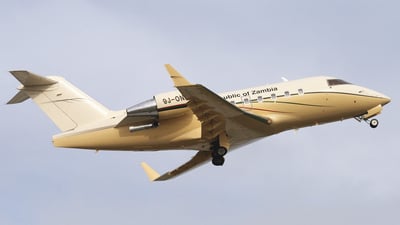
Zambia Air Force VVIP Aircraft - The Bombardier Challenger 600 series
The Bombardier Challenger 600 series is a family of business jets developed by Canadair after a Bill Lear concept, and then produced from 1986 by its new owner, Bombardier Aerospace. At the end of 1975, Canadair began funding the development of LearStar 600, and then bought the design for a wide-cabin business jet in April 1976. On 29 October, the programme was launched, backed by the Canadian federal government, and designed to comply with new FAR part 25 standards.
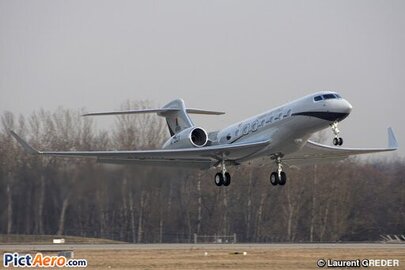
Zambia Air Force VVIP Aircraft - The Gulfstream G650
The Gulfstream G650 is a large business jet produced by Gulfstream Aerospace. The model is designated Gulfstream GVI in its type certificate, and may be configured to carry from 11 to 18 passengers. Gulfstream began the G650 program in 2005 and revealed it to the public in 2008. The G650 was formerly the company's largest and fastest business jet with a top speed of Mach 0.925, having been surpassed by the larger G700.
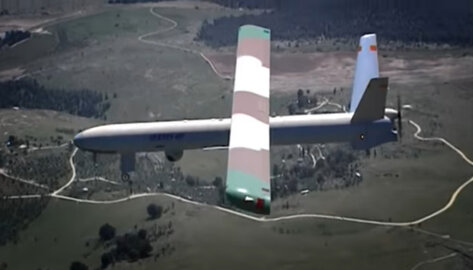
Zambia Air Force ISTAR Aircraft - The Elbit Hermes 450
The Elbit Hermes 450 is an Israeli medium-sized multi-payload unmanned aerial vehicle (UAV) designed for tactical long endurance missions. It has an endurance of over 20 hours, with a primary mission of reconnaissance, surveillance and communications relay. Payload options include electro-optical/infrared sensors, communications and electronic intelligence, synthetic-aperture radar/ground-moving target indication, electronic warfare, and hyperspectral sensors.
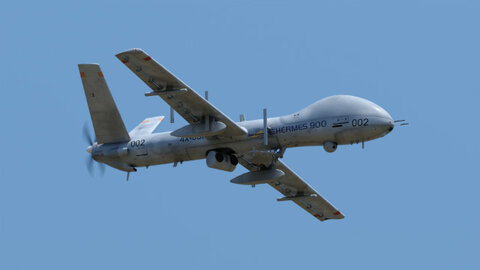
Zambia Air Force ISTAR Aircraft - The Elbit Systems Hermes 900 Kochav
The Elbit Systems Hermes 900 Kochav (Star) is an Israeli medium-size, multi-payload, medium-altitude long-endurance unmanned aerial vehicle (UAV) designed for tactical missions. It is a successor to the Hermes 450 series of drones, one of the most widely used military drones in the world.
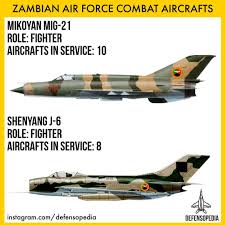
Zambia Air Force Combat Aircraft - The Shenyang J-6
The Shenyang J-6 (Chinese: 歼-6; designated F-6 for export versions; NATO reporting name: Farmer) is the Chinese-built version of the Soviet MiG-19 'Farmer' fighter aircraft, the world's first mass-produced supersonic aircraft.
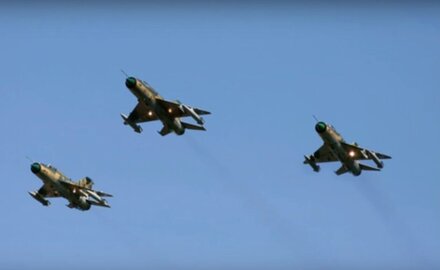
Zambia Air Force Combat Aircraft - The Mikoyan-Gurevich MiG-21
The Mikoyan-Gurevich MiG-21 (Russian: Микоян и Гуревич МиГ-21; NATO reporting name: Fishbed) is a supersonic jet fighter and interceptor aircraft, designed by the Mikoyan-Gurevich Design Bureau in the Soviet Union.
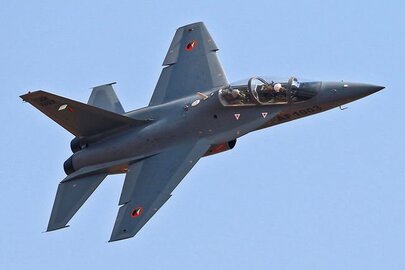
Zambia Air Force Combat Aircraft - Hongdu L-15B
Hongdu L-15B is a brand-new twin-seat battle fitness instructor created by the Hongdu Aeronautics Sector Group (HAIG), part of the China Aeronautics Market Firm (AVIC), for the People’s Liberation Military Air Force (PLAAF).
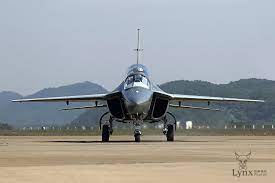
Zambia Air Force Combat Aircraft - Hongdu L-15B Cont'd
This is an innovative version of the L-15 supersonic instructor/ strike airplane. Nanchang-based Hongdu Aviation has increased weapon hard points on the L-15B from seven to nine, with a maximum payload of 3.5 metric tons. A sample weapon configuration could be PL-12 radar-guided beyond visual range missiles, LT-2 laser guided bombs and a centerline cannon pod.
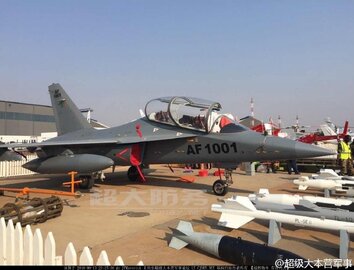
Zambia Air Force Combat Aircraft - Hongdu L-15B Cont'd
The aircraft can carry a weapon load of 3,500kg across nine hard-points. Each wing holds three hard-points, while each wing tip accommodates a single hard-point. The under-fuselage of the aircraft also holds a hard-point for weapons carriage. The L-15B can be armed with a range of weapon systems such as the PL-10 infrared-homing, short-range, air-to-air missiles, PL-12 active, radar-guided, beyond visual-range, air-to-air missiles, and PL-8 infrared-guided, short-range, air-to-air missiles, as well as LT-2 laser and LS-6 precision-guided bombs.
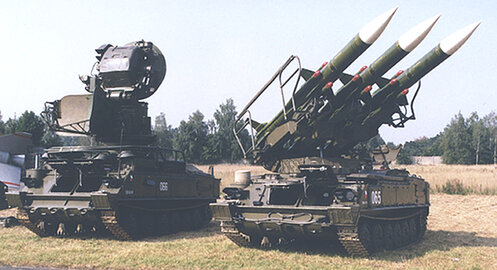
The legacy SAM systems Vs Contemporary SAM systems
There are major disparities in the recorded combat effectiveness of Soviet supplied Surface to Air Missile (SAM) systems, used in past decades, across theatres of operation. Most interesting is how poorly these SAM systems performed in the Middle East, compared to their combat effect in South East Asia. The study of SAM effectiveness in air campaigns between the 1960s and the last decade may span a period of almost a half century, but in every one of these campaigns the numerically dominant of these SAM systems have major disparities in the recorded combat effectiveness of Surface to Air Missile (SAM) systems, used in past decades, across theatres of operation.
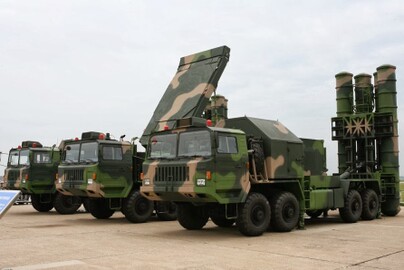
Effectiveness of the latest generation (Russian and Chinese) SAM systems.
The relevance of this arguably obscure historical detail, is that contemporary perceptions of the effectiveness of the latest generation of Russian and Chinese built SAM systems are more than often, in Western defence bureaucracies, determined on the basis of views such as “We trashed Russian SAMs completely in 1991, so why should we care about the effectiveness of current SAM systems?”. The latter argument has been put to this author more than once in recent times, by parties in Australia and overseas, so the perception that the effectiveness of state of the art new technology SAMs is no different to that of 1960s and 1970s technology SAMs operated in Middle East nearly two decades ago is widely held, and often fervently believed.

No fly Zones in the Modern Iron Skies
The material reality is that newer generation SAM systems such as the S-300PMU1, S-300PMU2 Favorit (SA-20), HQ-9/FD-2000/FT-2000 and S-400 Triumf (SA-21) are in terms of basic technology and performance very close to, if not better than the US MIM-104 Patriot series, and importantly, have never been challenged in combat by Western air forces, these including the formidable Israeli Air Force. The volume of detailed technical material now available from open sources on Soviet era SAM systems, specifically the SA-2 Guideline (S/SA-75 Volkhov/Dvina), SA-3 Goa (S-125 Neva/Pechora), SA-5 Gammon (S-200 Vega) and SA-6 Gainful (2K12 Kub/Kvadrat) is staggering, by Cold War era standards, and permits a much more focused and deeper analysis of the operational issues than was even possible using then limited classified source materials, during the Cold War period.
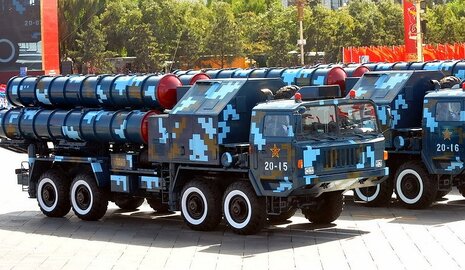
No fly Zones in the Modern Iron Skies CONT'D
In comparison with SAM systems currently available on the global market, offered by Russian and Chinese manufacturers, these legacy SAM systems of half a centuary ago are inferior in many respects:
►Modern SAM engagement and acquisition radars are designed from the outset to be highly resistant to jamming, and typically deliver higher peak power-aperture performance to engage lower signature targets;
►Some modern SAM engagement radars are claimed to provide a basic LPI (Low Probability of Intercept) capability, making their detection and tracking difficult;
►Nearly all modern SAM systems and supporting radars are highly mobile, engineered from the outset for “hide, shoot and scoot” operations;
►Modern SAMs are all kinematically superior to their Cold War era predecessors, by virtue of better rocket motor technology, and digital guidance, yielding greater engagement ranges and terminal endgame manoeuvre performance.
►Modern SAM engagement and acquisition radars are designed from the outset to be highly resistant to jamming, and typically deliver higher peak power-aperture performance to engage lower signature targets;
►Some modern SAM engagement radars are claimed to provide a basic LPI (Low Probability of Intercept) capability, making their detection and tracking difficult;
►Nearly all modern SAM systems and supporting radars are highly mobile, engineered from the outset for “hide, shoot and scoot” operations;
►Modern SAMs are all kinematically superior to their Cold War era predecessors, by virtue of better rocket motor technology, and digital guidance, yielding greater engagement ranges and terminal endgame manoeuvre performance.
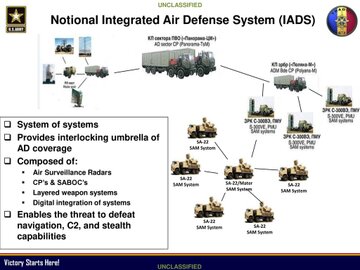
Intergration of Systems in the Modern SAM systems (Automation & User Friendly)
Contemporary SAM systems in these categories include the Russian SA-20 (S-300PMU1, S-300PMU2), Chinese HQ-9/FD-2000 and Russian S350, SA-21 (S-400). These are modern systems with highly jam resistant radars, and if the Chinese are correct, basic low probability of intercept capability. These systems will be difficult to locate, jam and guide anti-radiation missiles against. No less importantly they have modern highly automated digital fire control systems, not unlike Western SAMs of this era. The demands for proficiency and technical understanding of operation by crews seen in early Cold War SAM systems no longer exist – operators have sophisticated LCD panel displays with synthetic presentation. In deployment, these systems are heavily automated, using mostly hydraulic rams to elevate and unfold key system components, and thus little operator skill is needed to set up or relocate a battery – most can shoot and scoot in five minutes.
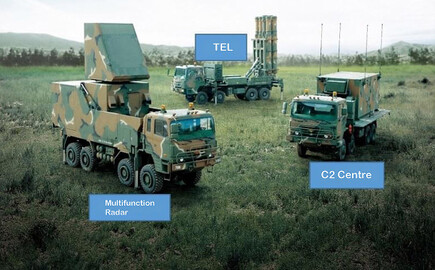
Air Defence in Depth (Layered Protection to Counter Every Enemy's Attack)
The difficulties arising from technological evolution in long range or area defence SAM systems have been exacerbated by the evolution of associated operational doctrine, which now sees the deployment of specialised equipment intended to defend SAM batteries from attack. These include:
►The development and deployment of advanced point defence SAMs and SPAAGMs to engage and destroy guided munitions launched against SAM sites;
►The development and deployment of modern emitting decoys to defeat geolocation receivers and guided munition seekers;
►The development and deployment of active and passive electronic, optical and infrared countermeasures to defeat guided munition seekers;
►The development and deployment of Cooperative Engagement Capability (CEC) sensor fusion systems to defeat electronic countermeasures, and to an extent, low observables.
►The development and deployment of advanced point defence SAMs and SPAAGMs to engage and destroy guided munitions launched against SAM sites;
►The development and deployment of modern emitting decoys to defeat geolocation receivers and guided munition seekers;
►The development and deployment of active and passive electronic, optical and infrared countermeasures to defeat guided munition seekers;
►The development and deployment of Cooperative Engagement Capability (CEC) sensor fusion systems to defeat electronic countermeasures, and to an extent, low observables.
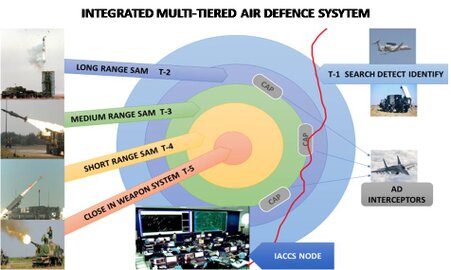
IADS in Modern SAM Systems (Air Defence Everywhere)
The term Air Defence (AD), is simplistically understood by most as defence of a nation’s territory from an enemy’s air attacks. For a professional air power practitioner however, AD today means much more. It encompasses a wider responsibility which includes net-centric and integrated surveillance, defensive and offensive kinetic measures, for the protection of a nation’s airspace, territory and maritime spaces, in the larger context of national interest. As a result, a modern IADS equipped with current Russian and Chinese SAM systems will be very difficult to defeat by non-lethal and lethal suppression or kill techniques. A large fraction of guided munitions launched will be shot down, or their guidance defeated. In conclusion, the perception that contemporary Russian and Chinese SAM systems can be defeated as easily as Syrian and Iraqi systems in 1982 and 1991 is nothing more than wishful thinking, arising from a complete failure to study and understand why and how SAM defences failed or succeeded in past conflicts.
Welcome to Air Power YouTube Channel - Subscribe now & click on the notification bell for latest features!
Zambia Air Force Future Air Power Platforms
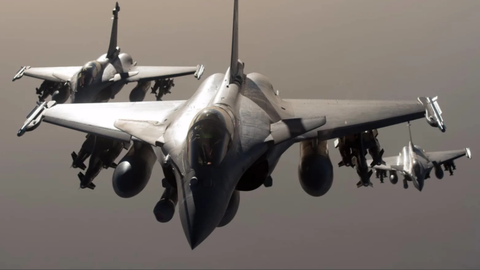
ZAF Future 4.5th Generation Multi-Role Fighter - The Rafale F4 (Omnirole by design; )
Versatile and best in all categories of missions, the Rafale is a true “Force Multiplier”. A fully optimized airframe; The Rafale, a fully “Omnirole” fighter, is available in three variants: the Rafale C single-seater operated from land bases, the Rafale M single-seater for carrier operations, the Rafale B two-seater flown from land bases. What makes the essential difference is the Rafale’s “multi-sensor data fusion” process running on data provided by all the sensors of the aircraft. In essence, the “multi-sensor data fusion” concept implemented into the Rafale allows the pilot to act as a true “tactical decision maker”, rather than being only a sensor operator. The mission system of the Rafale has the potential to integrate a variety of current and future armaments.
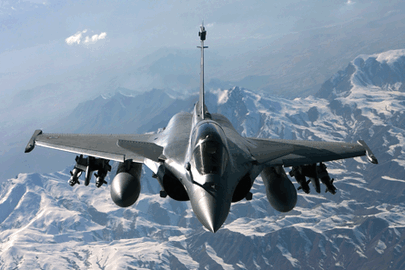
ZAF Future 4.5th Generation Multi-Role Fighter - The Rafale, with its “Omnirole” capabilities
The Rafale, with its “Omnirole” capabilities, is the right answer to the capability approach selected by an increasing number of governments. It fully complies with the requirement to carry out the widest range of roles with the smallest number of aircraft. The Rafale participates in permanent “Quick Reaction Alert” (QRA) / air-defense / air sovereignty missions, power projection and deployments for external missions, deep strike missions, air support for ground forces, reconnaissance missions, pilot training sorties and nuclear deterrence duties. The Air Force single-seat Rafale C, the Air Force two-seat Rafale B, and the Navy single-seat Rafale M feature maximum airframe and equipment commonality, and very similar mission capabilities.
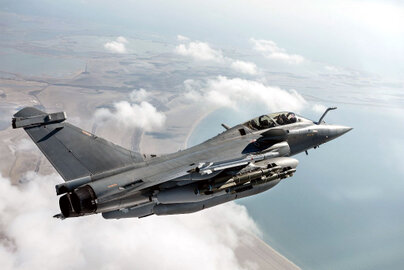
ZAF Future 4.5th Generation Omni-Role Fighter - The Rafale F4
Lessons learned from the latest conflicts where air power was used, can be summarized into four overarching expectations about weapon systems by political decision makers:
Versatility, that is the capability, with the same system, to perform different missions, Interoperability, or the ability to fight in coalition with the allies, using common procedures and standards agreements, and collaborating and communicating in real-time with other systems, Flexibility, which can be illustrated by the ability to conduct several different missions in the course of the same sortie (“Omnirole“ capability). With this capability, it is possible to switch instantly on the demand of a political decision maker, from a coercion mission (“strike force”) to a preventive mission (a dissuasive low-altitude, high-speed “show of force”), or even to cancel a mission until the last second (reversibility),
Survivability, that is the capability to survive in a dense threat environment thanks to stealthiness and / or to advanced electronic warfare systems.
Versatility, that is the capability, with the same system, to perform different missions, Interoperability, or the ability to fight in coalition with the allies, using common procedures and standards agreements, and collaborating and communicating in real-time with other systems, Flexibility, which can be illustrated by the ability to conduct several different missions in the course of the same sortie (“Omnirole“ capability). With this capability, it is possible to switch instantly on the demand of a political decision maker, from a coercion mission (“strike force”) to a preventive mission (a dissuasive low-altitude, high-speed “show of force”), or even to cancel a mission until the last second (reversibility),
Survivability, that is the capability to survive in a dense threat environment thanks to stealthiness and / or to advanced electronic warfare systems.
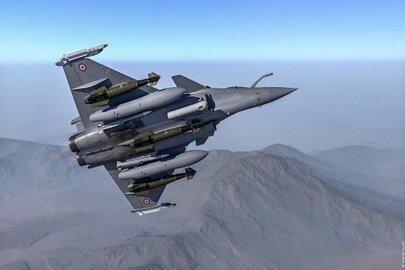
ZAF Future 4.5th Generation Omni-Role Fighter - The Rafale F4
The “Omnirole” Rafale combines all these advantages: it is relevant against both traditional and asymmetrical threats, it addresses the emerging needs of the armed forces in a changing geopolitical context, and it remains at the forefront of technical innovation.
Thanks to its versatility, its adaptability and its ability to meet all air mission requirements, the Rafale is the “poster child” transformational fighter which provides a way forward to air forces confronted to the requirement of doing “more” with “less”, in an ever-changing strategic and economic environment.
Of a moderate size, yet extremely powerful, superbly agile and very discrete, the latest type of combat aircraft from Dassault Aviation does not only integrate the largest and most modern range of sensors, it also multiplies their efficiency with a technological breakthrough, the “multi-sensor data fusion”.
Thanks to its versatility, its adaptability and its ability to meet all air mission requirements, the Rafale is the “poster child” transformational fighter which provides a way forward to air forces confronted to the requirement of doing “more” with “less”, in an ever-changing strategic and economic environment.
Of a moderate size, yet extremely powerful, superbly agile and very discrete, the latest type of combat aircraft from Dassault Aviation does not only integrate the largest and most modern range of sensors, it also multiplies their efficiency with a technological breakthrough, the “multi-sensor data fusion”.
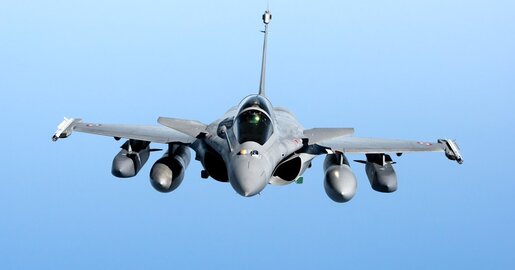
ZAF Future 4.5th Generation Omni-Role Fighter - The Rafale F4
The Rafale is a twin-jet fighter aircraft able to operate from both an aircraft carrier and a shore base. The fully versatile Rafale is able to carry out all combat aviation missions: air superiority and air defense, close air support, in-depth strikes, reconnaissance, anti-ship strikes and nuclear deterrence. The Rafale entered service with the French Navy in 2004 and with the French Air Force in 2006. Rafale is one of the most seasoned fighter in the world. It has been combat proven since 2007. The export success of the Rafale has been vindicated. Rafale has now more export orders than French orders. A wide range of smart and discrete sensors
The Rafale has a wide range of high-tech sensors: RBE2 radar, Front Sector Optronics, SPECTRA, DAMOCLES pod, etc.
The Rafale has a wide range of high-tech sensors: RBE2 radar, Front Sector Optronics, SPECTRA, DAMOCLES pod, etc.
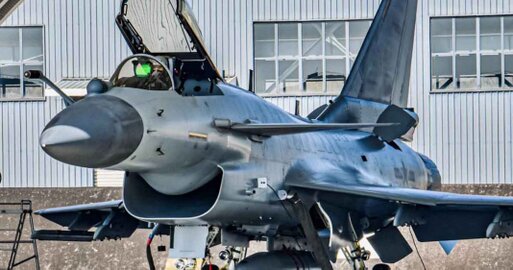
Zambia Air Force Next 4.5th Generation Combat Aircraft - Chengdu (AVIC) J-10C (Vigorous Dragon)
The J-10C is a medium-weight, all-weather jet that can be equipped with fourth-generation air-to-air missiles such as the short-range PL-10 and the beyond-visual-range PL-15. The jet can also feature a bigger active electronically scanned array (AESA) radar compared to the one installed in the JF-17 Block 3 jets, PTI reported.
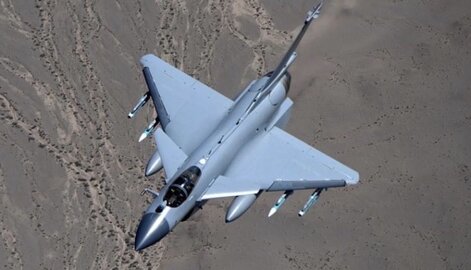
Zambia Air Force Next 4.5th Generation Combat Aircraft - Chengdu (AVIC) J-10C (Vigorous Dragon)
In the air-to-air mode, the J-10 can make use of the China's PL-15 (CH-AA-10a) extended range air-to-air missile is a fast-pacing weapon with a peak speed of above Mach 5, the PL-15 has a kinematic range of around 200 kilometres. The PL-15, however, appears to combine speed with manoeuvrability and beyond visual range. The missile is almost certainly fitted with an active electronically scanned array radar. It is integrated on the Chengdu J-20, J-10C, and Shenyang J-16. The PL-8, PL-9, PL-11 or PL-12 line of short- and medium-range air-to-air missiles. The PL-8 is a dual air-to-air/air-to-ground solution and based off of the Israeli Python 3. ThePL-9 is a short-range air-to-air missile with infra-red homing capability that can exceed speeds of Mach 3.0. ThePL-12 is a "beyond visual range" (BVR) medium-range air-to-air missile comparable to the American AIM-120 AMRAAM.
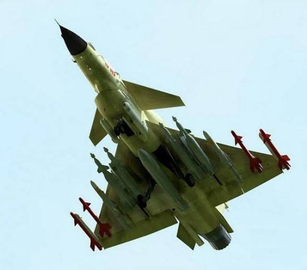
Zambia Air Force Next 4.5th Generation Combat Aircraft - Chengdu (AVIC) J-10C (Vigorous Dragon)
Air-to-surface weaponry is provided for by way of the PJ-9 and YJ-9K missiles. Conventional munitions arecomposed of general air-to-surface rocket pods (90mm caliber), laser-guided smart bombs (such as the LT-2),glide bombs (the LS-6, a satellite-guided munition) and traditional drop bombs of varying sizes (250kg to500kg). In addition to arms, the J-10 can sport up to 3 x external jettisonable fuel tanks for increased operationalranges. One such implement is carried along the centerline fuselage (about 450 gallons) whilst the other twocan be fi tted on cleared underwing hardpoints (212 gallons each).
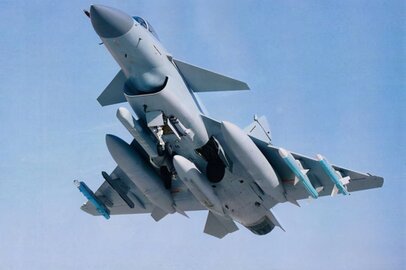
Zambia Air Force Next 4.5th Generation Combat Aircraft - Chengdu (AVIC) J-10C (Vigorous Dragon)
While standard armament for the J-10 is a twin-barrel Type 23-3 23mm cannon (offset to port under the intakenear the nose landing gear) the bread and butter of any multirole aircraft is in its ability to fi eld a wide variety of air-to-air and air-to-ground stores. The J-10 makes use of no fewer than eleven hardpoints (emplacementsalong the airframe cleared for munitions mounting) made up of six underwing (three to a wing) and five under-fuselage positions. The five underfuselage positions include a centerline hardpoint, a pair of forward-mountedhardpoints (near the intake opening) and a pair of aft-mounted hardpoints (about mid-fuselage) all centeredaround the external structure that makes up the intake assembly. Total munitions load has a reported limitation of up to 9,900lbs.
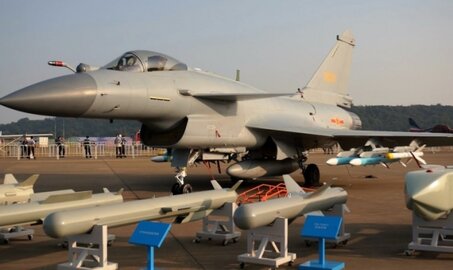
Zambia Air Force Next 4.5th Generation Combat Aircraft - Chengdu (AVIC) J-10C (Vigorous Dragon)
In addition to mounting destructive weaponry across its 11 hardpoints, the J-10 can also fi eld several avionicspods to help along in any given sortie. This includes the FILAT (Forward-looking, Infra-red Laser AttackTargeting) pod, the Blue Sky navigation/attack pod, the BM/KG300G jamming pod, the KZ900 electronicreconnaissance pod and the Type Hongguang infra-red search and track pod. The BM/KG300G is of indigenousorigin and primarily serves to combat all types of airborne and land-based pulse Doppler radar systems. The KZ900 is a relatively recent addition (late 1990s) to the Chinese military and is a fully-automatic reconnaissance pod designed to collect radar signals and provide for real-time order-of-battle. Blue Sky is thought to be basedon Western design after China received such a system by way of Saddam Hussein after claiming a downed Alliedaircraft in the Gulf War. FILAT is thought to be the Chinese equivalent of the Western AN/AAQ-14 targeting pod.
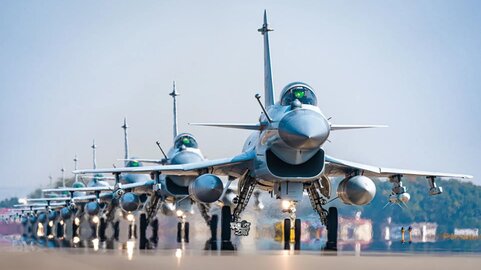
Zambia Air Force Next 4.5th Generation Combat Aircraft - Chengdu (AVIC) J-10C (Vigorous Dragon)
The J-10 makes use of a multi-target tracking and engagement suite. The fi re-control system is of an indigenousdesign and features a radar system capable of tracking up to 10 targets simultaneously with multiple targetengagement possible depending on the missile seeker type (two targets when using a semi-active radar homingand four targets when using an active radar-homing air-to-air missile). Its complexity and technical nature arebelieved to be on par with that as found on Western-type fourth generation fighters.

ZAF Future 4th Generation - The CAIC Z-10 Attack Helicopter
The CAIC Z-10 is an attack helicopter manufactured by Changhe Aircraft Industries Corporation (CAIC). Initially this helicopter was developed for the People's Liberation Army (PLA). Helicopters can be used primarily in anti-armor missions and war bans. Helicopters can also carry out limited air-to-air combat operations. The first flight of the CAIC Z-10 attack helicopter took place in April 2003. The first helicopter was sent to the PLA in 2009. The Z-10 helicopter was shown for the first time at the 9th China International Aviation and Aerospace Exhibition in Zhuhai in November 2012. Z-10 Helicopter touted comparable to western attack helicopters, including the AH-1 Cobra and AH-64 Apache.
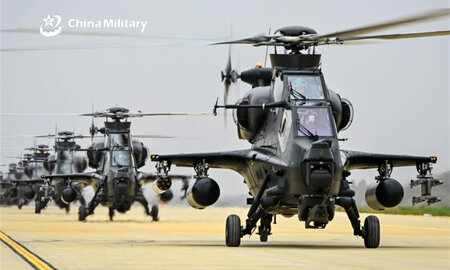
ZAF Future 4th Generation - The CAIC Z-10 Attack Helicopter
The CAIC Z-10 attack helicopter has a tandem stepping cockpit that accommodates shooters in the front and pilots in the back. The cockpit is equipped with an ejection seat and bulletproof glass canopy that can withstand 7.62 mm rotation. The cockpit is protected by composite armor. The CAIC Z-10 modern glass cockpit is equipped with multifunctional displays (MFDs), helmet-mounted eyesight with night vision goggles and a fly-by-wire (FBW) control system. The helicopter can be equipped with infrared forward-looking (FLIR) and low-light television and radar systems.
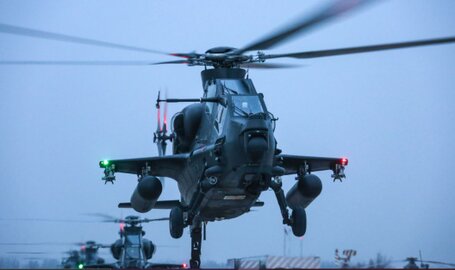
ZAF Future 4th Generation - The CAIC Z-10 Attack Helicopter
The CAIC Z-10 can be armed with a 20 mm or 30 mm autocannon on the chin tower. Two stub wings provide four hooks for holding external weapons. The GJV289A standard databus architecture allows the integration of Soviet and Western weapons systems. The helicopter can also adapt to use the newly developed HJ-10 guided anti-tank missile (ATGM). The missile is believed to be equivalent to the US-made AGM-114 Hellfire. Helicopters can carry up to eight ATGM for anti-armor roles, eight TY-90 air-to-air missiles and four PL-5, PL-7 and PL-9 air-to-air missiles. The TY-90 missile is specifically designed for helicopters conducting air combat missions. The Z-10 can also carry multi-purpose unrelated rocket pods for ground attack missions. A total of four pods under the sub wing can hold 57mm-90mm rockets. The CAIC Z-10 attack helicopter is equipped with an electronic countermeasure suite (ECM) that integrates radar warning receivers, laser warning receivers, infrared jammers and chaff / flare feed launch systems. The modular design also adapts the latest system, replacing the existing nuisance and bait launch system.
ZAF Future 4th Generation - The CAIC Z-10 Attack Helicopter
The CAIC Z-10 incorporates a conventional attack helicopter layout that features nail down fuselage and tandem cockpits. The fuselage has a tilted side design, tapers backward to reduce radar cross section. The helicopter is equipped with a five-bladed main rotor and a four-bladed tail rotor. Two engines were installed at the rear of the cockpit. The dimensions of the helicopter include a length of 14.1 m, diameter of the rotor 13 m. and 3.8 m high. The helicopter has a maximum take-off weight of 8 tons. The CAIC Z-10 attack helicopter is powered by two Canadian PT6C-67C Pratt & Whitney turboshaft engines. Each engine is capable of producing a maximum continuous output power of 1,142 kW. The machine is equipped with a Full Engine Digital Control (FADEC) system.
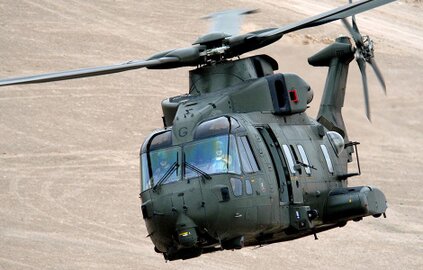
ZAF Future 4th Generation Tactical Medium Lift - AW101 (EH101) Merlin / Cormorant Utility Helicopter
The AW101 (EH101) military utility medium lift helicopter is manufactured by global aerospace and defence company Leonardo Company. It was previously manufactured by AgustaWestland (formerly EH Industries), a joint venture company formed by Italy’s Agusta and British company GKN. AgustaWestland merged into Leonardo, which was previously known as Finmeccanica, in 2016. The multi-role helicopter can be flexibly deployed on missions such as tactical troop transport, utility support, maritime interdiction operations, reconnaissance, anti-surface warfare, and search and rescue (SAR) operations. The EH101 helicopter was renamed the AW101. It is also produced in naval and civil versions.The most important aspect of the helicopter’s design is the common platform that can be configured into multiple roles.
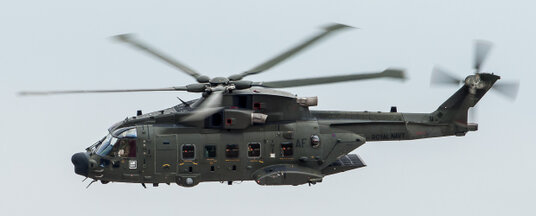
ZAF Future 4th Generation Tactical Medium Lift - AW101 (EH101) Merlin / Cormorant Utility Helicopter
The cockpit is equipped with armoured crew seats able to withstand an impact velocity of 35ft/s. Dual flight controls are provided for the pilot and co-pilot, but the helicopter is capable of being flown by a single pilot. The pilot’s mission display unit is supplied by Northrop Grumman (formerly Litton). The electronic instrument system includes six high-definition, full-colour displays, together with an optional mission display. A forward-looking infrared (FLIR) system display and digital map can be installed. Portuguese and Danish Air Force helicopters have FLIR Systems Star SAFIRE thermal imagers. DRS Technologies of the USA supplies the flight control computers.
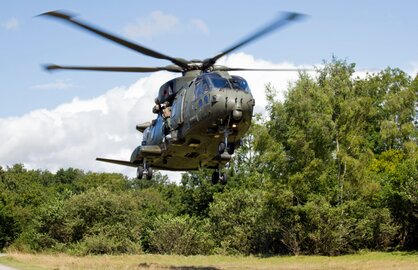
ZAF Future 4th Generation Tactical Medium Lift - AW101 (EH101) Merlin / Cormorant Utility Helicopter
Armament options for military utility variants include a chin turret for a 12.7mm machine gun or pintle-mounted machine gun. The stub wings provide the hard points for mounting of rocket pods. The AW101 transport helicopter is armed with five general-purpose machine guns, two 960kg (2,116lb) anti-ship missiles, four homing torpedoes, depth charges, and rockets. Countermeasures of AW101; The AW101 is equipped with infrared jammers, such as the Northrop Grumman Nemesis, directed infrared countermeasures, missile approach warners, chaff and flare dispensers, and a laser detection and warning system.
Cargo systems; The military version AW101 has accommodation for 30 seated or 45 standing fully equipped combat troops. The cabin has room for a medical team and 16 stretchers or for palleted internal loads. The maximum ramp load is 3,050kg for vehicles such as Land Rovers. The heavy-duty cabin floor and ramp are equipped with flush tie-down points, a roller conveyer for palleted freight and a cargo winch for non-self-loading freight. An underslung load hook can carry external loads up to 12,000lb, and the load measurement is displayed in the cockpit. A rescue hoist and a hover trim controller are fitted at the cargo door.
Cargo systems; The military version AW101 has accommodation for 30 seated or 45 standing fully equipped combat troops. The cabin has room for a medical team and 16 stretchers or for palleted internal loads. The maximum ramp load is 3,050kg for vehicles such as Land Rovers. The heavy-duty cabin floor and ramp are equipped with flush tie-down points, a roller conveyer for palleted freight and a cargo winch for non-self-loading freight. An underslung load hook can carry external loads up to 12,000lb, and the load measurement is displayed in the cockpit. A rescue hoist and a hover trim controller are fitted at the cargo door.
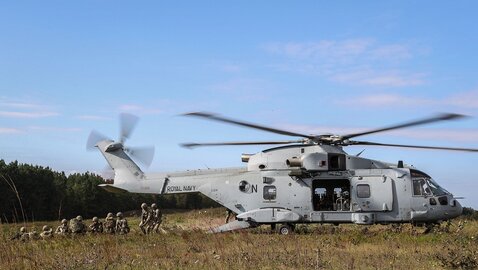
ZAF Future 4th Generation Tactical Medium Lift - AW101 (EH101) Merlin / Cormorant Utility Helicopter
The military version of the AW101 is powered by either three General Electric CT7-6 turboshaft engines, rated at 1,491kW, or three Rolls-Royce Turbomeca RTM322 turboshaft engines, rated at 1,567kW. Each engine is fed from a dedicated self-sealing fuel tank using dual booster pumps and a cross-feed system. The Rolls-Royce engine has been chosen by UK, Canada, Japan, Denmark and Portugal. The GE engine was selected by Italy. The three tanks hold 3,222l of fuel. The fourth tank acts as a reservoir supply to top up the main tanks during flight. There is capacity for an additional transfer tank to increase the helicopter’s range. The range can be extended by the hover in-flight refuelling (HIFR) capability. The crew can select pressure for refuel, defuel, jettison and buddy-to-buddy refuelling.
Performance; The AW101 transport helicopter can fly at the rate of 10.2m/s. The maximum and cruise speed of the helicopter are 309km/h and 278km/h respectively. The maximum range and service ceiling are 927km and 4,575m, and the maximum endurance is four hours 50 minutes. The helicopter weighs around 10,500kg and the maximum take-off weight is 15,600kg.
Performance; The AW101 transport helicopter can fly at the rate of 10.2m/s. The maximum and cruise speed of the helicopter are 309km/h and 278km/h respectively. The maximum range and service ceiling are 927km and 4,575m, and the maximum endurance is four hours 50 minutes. The helicopter weighs around 10,500kg and the maximum take-off weight is 15,600kg.
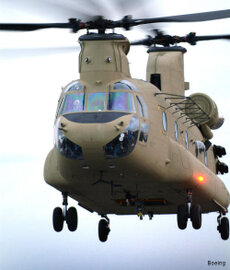
ZAF Future 4th Generation Heavy-Lift Utility & Transport Helicopter - CH-47D/F / MH-47E Chinook (Joint Logistics & Tactical Airlifter)
Chinook CH-47F is primarily deployed in the transportation of troops, artillery, supplies and equipment to the battlefield. The Chinook CH-47F is an advanced multi-mission helicopter manufactured by American aerospace and defence firm Boeing for the US Army and international defence forces. The CH-47D Chinook helicopter is used for the transportation of troops, artillery, supplies, and equipment to the battlefield. Other roles include medical evacuation, aircraft recovery, parachute drop, search and rescue, disaster relief, fire-fighting and heavy construction. More than 1,179 Chinooks are operational worldwide. Boeing delivered more than 480 CH-47D Chinooks to the US Army and National Guard. The US Army Chinooks underwent digital improvement to keep the aircraft on the war field for more than 20 years.
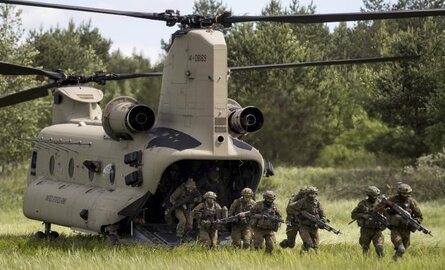
ZAF Future 4th Generation Heavy-Lift Utility & Transport Helicopter - CH-47D/F / MH-47E Chinook (Infantry & Artillery Transport Operations)
The CH-47F design features alterations to the airframe structure to reduce the effects of vibration, as well as other structural enhancements to the cockpit, cabin, aft section, pylon and ramp. The CH-47F is an advanced multi-mission helicopter for the U.S. Army and international defense forces. It contains a fully integrated, digital cockpit management system, Common Avionics Architecture System (CAAS) Cockpit and advanced cargo-handling capabilities that complement the aircraft's mission performance and handling characteristics. Formation to the Future: The latest modernization initiative known as Chinook Block II is a testament to the robustness of the Chinook’s original design and its 55-year legacy of technological advancements. With these new capabilities, Boeing is ensuring that the iconic H-47 remains the most reliable, capable and ready medium-to-heavy-lift helicopter into the 2060s and beyond
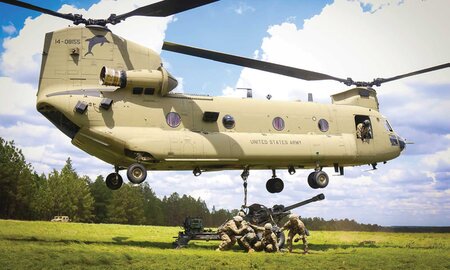
ZAF Future 4th Generation Heavy-Lift Utility & Transport Helicopter - CH-47D/F / MH-47E Chinook (Infantry & Artillery Transport Operations)
The CH-47D Chinook is the U.S. Army’s primary heavy troop and supply transport aircraft. Originally fielded in the Vietnam War, the CH-47 has undergone a series up upgrades to increase lift and airworthiness in combat environments. Beginning in 1982 and ending in 1994, all CH-47A, B and C models were upgraded to the CH-47D version, which remains the U.S. Army standard and features composite rotor blades, an improved electrical system, modularized hydraulics, triple cargo hooks, avionics and communication improvements, and more powerful engines that can handle a 19,500 lb load – nearly twice the Chinook’s original lift capacity. An upgrade program exists to remanufacture 300 of the current fleet of 425 CH-47D’s to the CH-47F standard. The MH-47E is the Special Forces variant of the Chinook and will be remanufactured to the MH-47G.
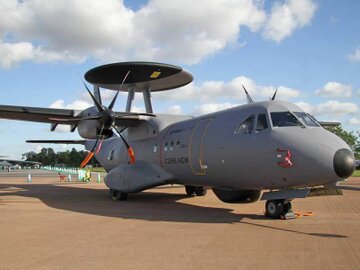
ZAF Future 4th Generation Multi-Role Tactical Medium Airlifter C295 Airbus
The world’s most versatile and efficient Transport Aircraft - Airbus’ new generation C295 is a robust, reliable and highly versatile tactical transport that is tailored for missions that range from carrying troops and cargo, maritime patrol, airborne warning, surveillance and reconnaissance to signals intelligence, armed close air support, medical evacuation, VIP transport and airborne firefighting. It is capable of carrying up to nine tonnes of payload or as many as 71 troops at a maximum cruise speed of 260 kts. Adding to its flexibility is the capability of being equipped for the air-to-air refueling of fixed-wing aircraft and helicopters.

ZAF Future 4th Generation Multi-Role Tactical Medium Airlifter C295 Airbus
Fitted with a retractable landing gear and featuring an unobstructed 12.69-meter-long pressurized cabin, the C295 cruises at altitudes up to 30,000 ft., while also retaining excellent low-level flight characteristics. It has remarkable short take-off & landing (STOL) performance from unpaved, soft, and sandy/grass airstrips. The C295 is powered by two Pratt & Whitney Canada PW127G turboprop engines that provide excellent manoeuvrability, outstanding hot-and-high performance, with fuel consumption for a very long endurance of up to 13 hours aloft. With more than 200 aircraft in operation, the C295 has an outstanding track record of reliability, demonstrating daily its worth as a highly efficient workhorse. The C295’s baseline now includes winglets that provide even better performance in all phases of flight, delivering improved takeoff characteristics at hot and high airfields, enabling higher cruise altitudes (especially at higher weights), increasing endurance, and reducing overall fuel consumption by three to six percent. C295 operators have logged a combined 500,000 flight hours in all types of environments, demonstrating the effectiveness and soundness of the aircraft and system design. The C295 is the perfect “workhorse” offering unique versatility and proven reliability for the needs, of military forces, governments and non-governmental agencies – today and tomorrow.
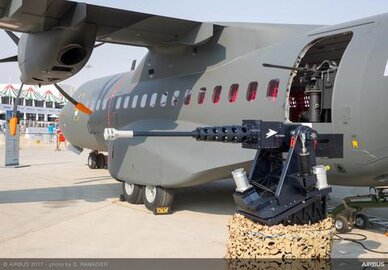
ZAF Future 4th Generation Multi-Role Tactical Medium Airlifter C295 Airbus
Proven with the world’s armed forces; The C295 is combat proven, having been successfully used during long deployments (up to two years, flying as many as 100 hours per aircraft per month) in remote areas such as Chad, Iraq and Afghanistan. It routinely operates in the hot and humid conditions of the Brazilian jungle and Colombian mountains, in the dusty and very hot deserts of Egypt and Algeria, and in the extremely cold and icy winters of Poland, Finland and Kazakhstan. The C295 offers optional self-protection equipment that has been in service across such hostile environments as Iraq and Afghanistan, including cockpit armour, chaff/flare dispensers, along with radar warning (RWR), missile warning (MAWS) and laser warning (LWS) systems. In-flight refuelling capability is an option for the aircraft. Working for the benefit of society; The C295 is widely used for humanitarian and other non-military operations by a variety of governmental and non-governmental agencies. Missions include disaster relief flights; search and rescue (SAR); and such surveillance and control duties as the monitoring of illegal immigration, drug smuggling, piracy, illegal fishery; as well as maritime pollution control and deterrence, and the monitoring of deforestation. With its short take-off and landing (STOL) characteristics and the ability to use unprepared airstrips, C295s are deployed for resupply trips into remote locations.
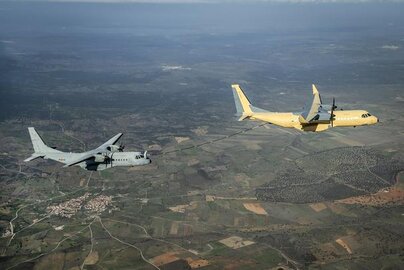
ZAF Future 4th Generation Multi-Role Tactical Medium Airlifter C295 Airbus
C295 variants
Excellent versatility, diverse missions and multiple variants…all in one aircraft: these are the key attributes that make Airbus’ C295 the benchmark airlifter in its category. Most variants can easily be configured/re-configured with the use of palletised modular mission systems. Tactical Transporter; The highly versatile airlifter that is rapidly reconfigurable to meet varied mission requirements. Versatile Maritime Surveillance (MSA)
A true multi-role aircraft for persistent surveillance in maritime and overland operations. MPA/ASW
Long on-station duration, combined with Airbus’ Fully Integrated Tactical System (FITS), make the C295 the perfect platform for maritime patrol and anti-submarine warfare missions.
Excellent versatility, diverse missions and multiple variants…all in one aircraft: these are the key attributes that make Airbus’ C295 the benchmark airlifter in its category. Most variants can easily be configured/re-configured with the use of palletised modular mission systems. Tactical Transporter; The highly versatile airlifter that is rapidly reconfigurable to meet varied mission requirements. Versatile Maritime Surveillance (MSA)
A true multi-role aircraft for persistent surveillance in maritime and overland operations. MPA/ASW
Long on-station duration, combined with Airbus’ Fully Integrated Tactical System (FITS), make the C295 the perfect platform for maritime patrol and anti-submarine warfare missions.
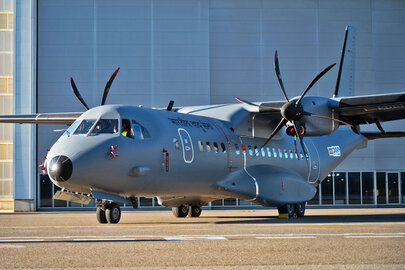
ZAF Future 4th Generation Multi-Role Tactical Medium Airlifter C295 Airbus
Armed/Ground ISR; The Intelligence Surveillance and Reconnaissance version with a multi-mission radar also can be weaponised to conduct effective close-air-support operations. SIGINT; Complete interception of electromagnetic (ELINT) and communication (COMINT) emissions provide a high level of battlefield situational awareness and generate an intelligence advantage. AEW; In its Airborne Early Warning version, the C295 carries the state-of-the-art AESA radar for 360-degree coverage to provide a full picture of the airspace.
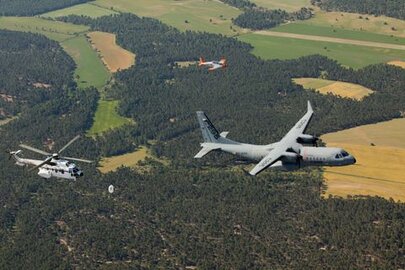
ZAF Future 4th Generation Multi-Role Tactical Medium Airlifter C295 Airbus
Air-to-air refueling; With a removable refuelling kit, the C295 can be easily transformed into an air tanker that is able to provide up to 6,000 kg. of fuel to fixed-wing and helicopter receivers. Medical evacuation
In the MEDEVAC configuration, the C295 can be fitted with up to 24 stretchers plus seven medical attendants. Intensive care configurations also are possible. Water Bomber; A versatile roll-on/roll-off system converts the C295 into an efficient water bomber to fight forest fires with up to 7,000 litres of water or retardant.
In the MEDEVAC configuration, the C295 can be fitted with up to 24 stretchers plus seven medical attendants. Intensive care configurations also are possible. Water Bomber; A versatile roll-on/roll-off system converts the C295 into an efficient water bomber to fight forest fires with up to 7,000 litres of water or retardant.
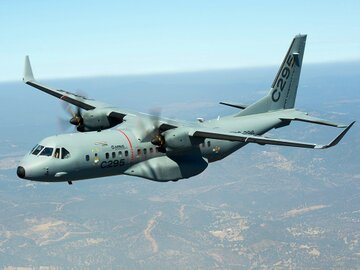
ZAF Future 4th Generation Multi-Role Tactical Medium Airlifter C295 Airbus
Entirely conceived and developed by Airbus Defence and Space, the Fully Integrated Tactical System (FITS) is the C295’s core mission system, enabling the aircraft to carry out duties that range from anti-submarine and anti-surface warfare (ASW/ASuW) to search and rescue (SAR), maritime patrol, signals intelligence and environmental protection, among others. FITS consists of an onboard suite of networked computers and displays that directly provide the crews with the required information in a processed manner, allowing them to perform missions much easier and more efficiently. In the complex arena of surveillance operations, the design challenge for FITS was not just to gather data from today’s sophisticated multiple sensors, but to process and present the information in an “intelligent” way to let the crew act on it. This modular, flexible and adaptable system collects, classifies and displays the various types of sensor data gathered in different types of surveillance missions and provides it to the crew via a highly intuitive interface. The result is maximised operational effectiveness, thanks to the enhanced level of information integration and reduced workload onboard the aircraft. FITS consists of multi-function crew consoles, connected to central processors via a high-speed local area network (LAN) and also linked to the aircraft navigation and communication systems.
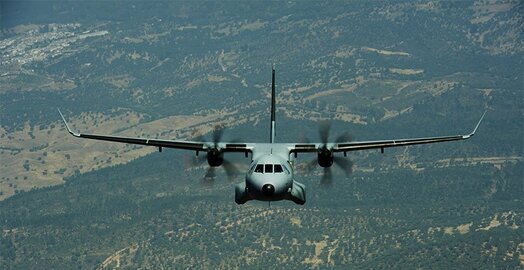
ZAF Future 4th Generation Multi-Role Tactical Medium Airlifter C295 Airbus
The airborne segment is complemented by a ground-based support centre for mission analysis and training. Typical FITS configurations vary from two consoles on the C295 Maritime Surveillance Aircraft (MSA) to five consoles on versions for maritime patrol (MPA), anti-submarine warfare (ASW) and signals intelligence (SIGINT) missions. Sensors currently integrated with FITS include radar, electro-optic/infrared (EO/IR), acoustics, magnetic anomaly detector (MAD), automatic identification system (AIS), identification friend or foe (IFF) interrogator, communications and electronic intelligence (COMINT/ELINT), and sea pollution detection systems. FITS also is integrated with the aircraft’s navigation and communications systems, including VHF/UHF/HF radios, satellite communications (SATCOM), and high-frequency Link 11 and Link 16 datalinks. In the anti-submarine warfare role, it additionally integrates sonobuoy and armament inventory management, plus launch pattern control. FITS’ flexibility and modularity give it excellent growth capability, allowing the system to handle new and updated sensors, along with additional consoles as technology and operational requirements evolve. As such, it will be an integral part of the C295’s Airborne Early Warning (AEW) version.
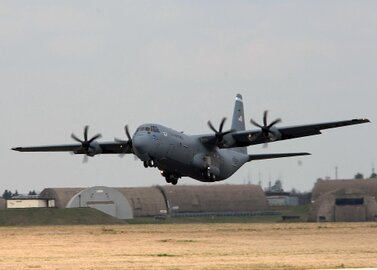
ZAF Future 4th Generation Heavy Transport Aircraft (Proven Multirole, Multimission Capabilities) - C-130J-30 Super Hercules
The C-130J-30 is a stretch version of the C-130J, a proven, highly reliable and affordable airlifter. The C-130J-30 adds 15 feet to the fuselage, increasing usable space (two more pallets of equipment) in the cargo compartment. The Lockheed Martin C-130 is the US Air Force’s principal tactical cargo and personnel transport aircraft. The C-130J Hercules is the latest model, featuring a glass cockpit, digital avionics and a new propulsion system with a six-bladed propeller. The Block 8.1 configuration contains software and hardware capability expansion such as modernised identification friend or foe (IFF), automatic dependent surveillance broadcast, communication, navigation and air traffic management datalink.
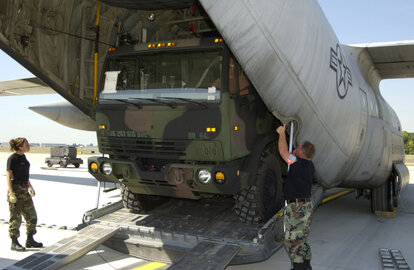
ZAF Future 4th Generation Heavy Transport Aircraft - C-130J Hercules Tactical Transport Aircraft,
C-130J is crewed by two pilots and a loadmaster. The new glass cockpit features four L-3 systems with multifunction liquid crystal displays for flight control and navigation systems. Each pilot has a Flight Dynamics head-up display (HUD). Supplied by BAE Systems IEWS, the dual mission computers, operate and monitor the aircraft systems, and provide status updates for the crew. The cockpit is fitted with the Northrop Grumman low-power colour radar display. The map shows digitally stored image data. The C-130J is equipped with a Honeywell dual-embedded global positioning system/inertial navigation system (GPS/INS), an enhanced traffic alerting and collision avoidance system (E-TCAS), a ground collision avoidance system, SKE2000 station keeping system, and an instrument landing system (ILS).
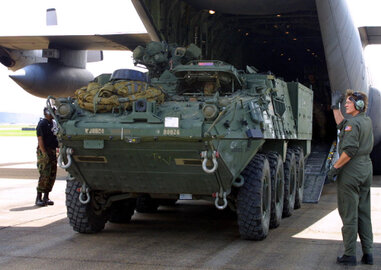
ZAF Future 4th Generation Heavy Transport Aircraft - C-130J Hercules Tactical Transport Aircraft,
The cargo bay of the C-130J has a total usable volume of more than 4,500ft³ and can accommodate loads up to 37,216lb. For example, three armoured personnel carriers, five pallets, 74 litters (stretchers), 92 equipped combat troops or 64 paratroops. The bay is equipped with cargo handling rollers, tie-down rings, stowage containers, and stowage for troop seats. The Lockheed Martin AN/ALQ-157 infra-red countermeasures system generates a varying frequency-agile infrared jamming signal. The infrared transmitter is surface-mounted at the aft end of the main undercarriage bay fairing. USAF selected the Northrop Grumman Large Aircraft Infra-red Countermeasures (LAIRCM) system, an additional electronic warfare self-protection (EWSP) system, to equip its C-130 aircraft. LAIRCM is based on the AN/AAQ-24(V) NEMESIS.
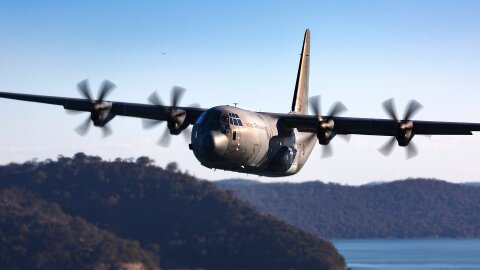
ZAF Future 4th Generation Heavy Transport Aircraft - (C-130J-30 stretch version) Tactical Transport Aircraft
The C-130J is the latest addition to the C-130 fleet and has replaced aging C-130Es and some of the high time C-130Hs. The C-130J incorporates state-of-the-art technology, which reduces manpower requirements, lowers operating and support costs, and provides life-cycle cost savings over earlier C-130 models. Compared to older C-130s, the J model climbs faster and higher, flies farther at a higher cruise speed, and takes off and lands in a shorter distance. The C-130J-30 is a stretch version, adding 15 feet to the fuselage, increasing usable space in the cargo compartment. C-130J/J-30 major system improvements include advanced two-pilot flight station with fully integrated digital avionics, color multifunctional liquid crystal and head-up displays and state-of-the-art navigation that includes a dual inertial navigation system and GPS. The aircraft also features fully integrated defensive systems, low-power color radar, digital moving map display, new turboprop engines with six-bladed all-composite propellers and a digital auto pilot. The C-130J/J-30 also includes improved fuel, environmental and ice-protection and an enhanced cargo-handling system.
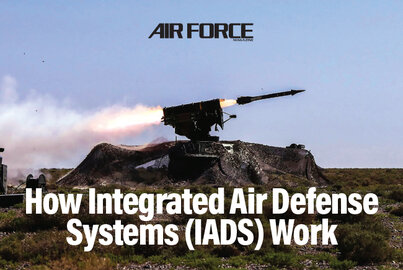
Defence Economics; C4Is enables IADS to operate with minimal costs while utilising economy of effort and diterrence.
Policing the Skies with an IRON HAND is what an effective IADS with C4I Platforms perfoming three functions—air surveillance, battle management, and weapons control. Of these, air surveillance alone includes five specific sub-functions: detect, initiate, identify, correlate, and maintain. Air surveillance is often described as the “eyes” of an air defense system. A radar will “detect” an aircraft entering an IADS’s area of coverage, while the “initiate” function transforms radar returns into “tracks.” The “identify” function examines the track and categorizes it as friend, foe, or unknown.

Defence Economics; C4Is enables IADS to operate with minimal costs while utilising economy of effort and diterrence Cont'd
After surveillance, the battle management aspect of an IADS includes four functions: Threat evaluation, engagement decision, weapon selection, and engagement authority. Battle management marks the transition from identifying a threat to acting against it. Battle management makes the determination that a given radar track is in fact a threat and then selects the weapon to counter that threat. The engagement authority is the final step in battle management that confirms the threat, engagement, and weapon selection decisions.

Defence Economics; C4Is enables IADS to operate with minimal costs while utilising economy of effort and diterrence Cont'd
These decisions transition into weapons control, where a particular weapon system performs the weapons pairing, acquiring, tracking, guiding, killing, and assessing functions. Within weapons control, even more refined degrees of air surveillance and battle management tasks are occurring too. The difference is these are strictly related to the specific weapon that is engaging a threat. As a result, the control functions and guidance aspects of air defense are often analyzed more than other elements of an IADS’ kill chain.
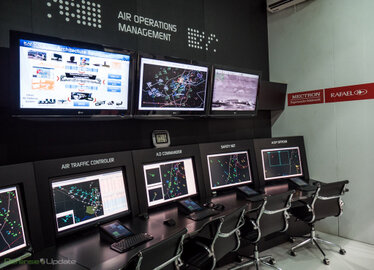
Defence Economics; C4Is enables IADS to operate with minimal costs while utilising economy of effort and diterrence Cont'd
The complexity of modern command, control, communications, computers, and intelligence (C4I) systems, and processes used by IADS are often underestimated and so are the potential impact of C4I on military operations. Use of information technology to make a commander's situational awareness better also creates the potential to improve the effectiveness with which the commander directs and controls his forces. C4Is enables Decentralized Freedom of Action for Commanders in the battlefield and can use C4Is to Conduct Precision Strikes, thus enhancing the Effectiveness of Air Operations.
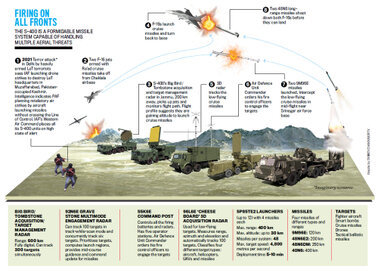
Defence Economics; C4Is enables IADS to operate with minimal costs while utilising economy of effort and diterrence Cont'd
This is because capabilities such as fire-control radars and missile batteries that make decisions and have their own radars are perceived as performing these functions across the entire system, irrespective of a weapon’s role or responsibility in a larger IADS. Modern IADS leverage multiple communications channels, including traditional landlines, fiber-optic networks, and radio frequency and electromagnetic spectrum links. No longer can an operation against a modern IADS plan to achieve a singular effect against a singular node or IADS means of communication.

Defence Economics; C4Is enables IADS to operate with minimal costs while utilising economy of effort and diterrence Cont'd
The system is designed to enhance combat capability in fighter aircraft, command and control platforms, and surface air defense units, and it provides a data transfer link between weapon platforms and C4I systems for real-time situation awareness, targeting, and mutual support. Advanced C4I offers the means to achieve greatly improved effectiveness in carrying out most of the challenging tasks in air operations. The single integrated air picture is critical to improving the effectiveness of the air and missile defense missions.
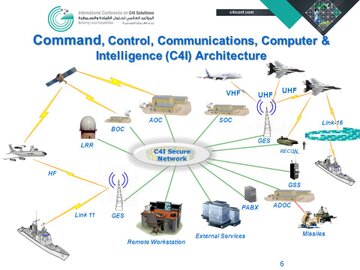
Defence Economics; The Role of C4I Systems in Future Military Environments
One of the major requirement of a modern Air Force core competency is information superiority through agile combat support, and the committment is to ensure that this component is achieved through innovation in order to better understand the potential offered by advanced technologies. The C4Is enables military operations other than war and those of counterterrorist operations and operations against insurgency more objective and efficient.
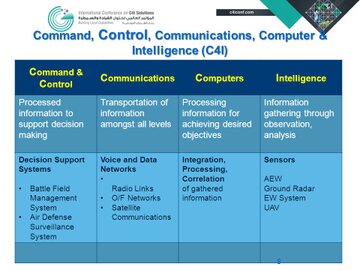
Defence Economics; The Role of C4I Systems in Future Military Environments Cont'd
In the area of information superiority, the Air Force will focus on future global battle management/command and control systems to allow for real-time control and execution of all air and space missions, exploit unmanned aerial vehicle technology(especially in intelligence, surveillance, and reconnaissance and communications applications), and expand its defensive information warfare efforts.
Zambia Air Force - Mentorship
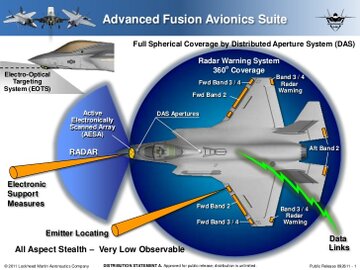
Airpower is Technologically Driven by concepts of combat enabling capabilities
The evolution of airpower and the ever-increasing component of stealth technology in dictating warfare, based on the need to integrate and place them in the right perspective. Hence, the role of stealth aircraft and the dominance of all aspects of stealth technology, especially in recent conflicts, are reviewed. The integration of the fundamental aspects of stealth technology, through its classification, types of aircraft signatures: especially radar, infrared, and visual signatures, their sources of origin, modelling techniques, and methods of signature reduction are discussed. Due to the increasing importance of infrared signatures relative to radar signatures, infrared signatures are also closely examined and analysed. Hence, the lock-on and surveillance ranges of infrared detectors are compared. Future projections in stealth technology, especially based on the role of anti-stealth technologies, are also elaborated.

F-35 Lightning II - Transformational Capability From Air to Everything in the Battlespace
As adversaries advance and legacy aircraft age, the 5th Generation F-35 is critical to maintaining air dominance now and for decades to come. 5th Generation capability is defined by the combination of Very Low Observable stealth, advanced sensors, information fusion and network connectivity – all packaged within in a supersonic, long range, highly maneuverable fighter. More than a fighter jet, the F-35’s ability to collect, analyze and share data, is a powerful force multiplier that enhances all airborne, surface and ground-based assets in the battlespace.
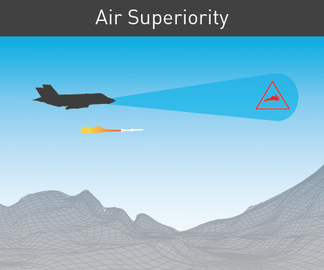
F-35 Lightning II - Air Superiority
VLO Stealth - With stealth designed in from day one, the F-35 has an unmatched ability to evade enemy detection and enter contested airspace.
Supersonic Speed and Extended Range - The Pratt & Whitney F135 is the most powerful fighter engine in the world. At Mach 1.6, the F-35 is a long range, supersonic fighter, even with a full compliment of internal weapons and fuel.
Supersonic Speed and Extended Range - The Pratt & Whitney F135 is the most powerful fighter engine in the world. At Mach 1.6, the F-35 is a long range, supersonic fighter, even with a full compliment of internal weapons and fuel.
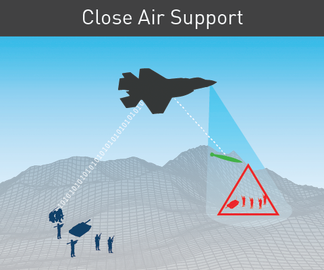
F-35 Lightning II - Close Air Support
Weapons Capacity - The F-35 carries weapons internally in stealth configuration, or externally in permissible environments with greater than 18,000 pounds of total ordinance.
Network Enabled Ops - The F-35 serves as an information and communications gateway, sharing its operational picture with the ground, sea and air assets.
Network Enabled Ops - The F-35 serves as an information and communications gateway, sharing its operational picture with the ground, sea and air assets.
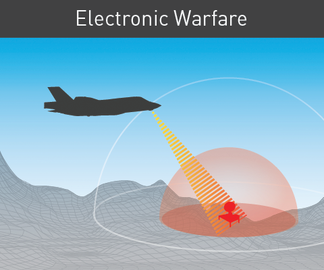
F-35 Lightning II - Electronic Warfare System
Electronic Warfare System - Advanced EW capabilities to locate/track enemy forces, jam radars and disrupt attacks.
Sensor Fusion - F-35’s advanced sensor fusion creates a single integrated picture of the battlefield that greatly enhances awareness, survivability and lethality.
Sensor Fusion - F-35’s advanced sensor fusion creates a single integrated picture of the battlefield that greatly enhances awareness, survivability and lethality.
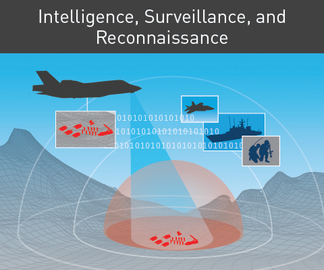
F-35 Lightning II - Intelligence, Surveillance & Reconnaissance
The F-35 has the most advanced sensor suite of any fighter in history, including the Active Electronically Scanned Arrays (AESA) radar, Distributed Aperture System (DAS), Electro Optical Targeting System (EOTS) and Helmet Mounted Display System.
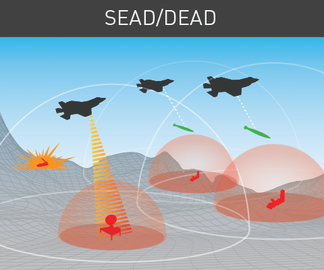
F-35 Lightning II - SEAD & DEAD
Active electronically-scanned array radar provides long-range intelligence. The F-35's advanced HMD provides pilots with unmatched situational awareness in diverse conditions. DAS sends high resolution real-time imagery to the pilot’s helmet from six infrared cameras mounted around the aircraft. EOTS combines forward-looking infrared and infrared search and track functionality.
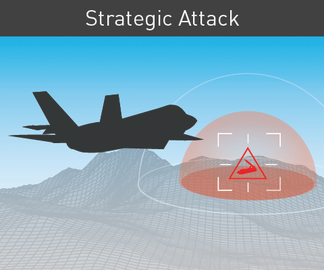
F-35 Lightning II - Strategic Attack
With this advanced technology, the F-35 is a multi-role fighter capable of successfully executing any and all mission, including new missions not traditionally fulfilled by legacy fighters. Where 4th generation fighters are forced to adapt to this advancing battlespace, the F-35 shifts the power dynamic and is able to define the battlespace that our adversaries will need to adapt to.

Why the S-400 Missile is Highly Effective — If Used Correctly
The S-400 Triumph air defence system integrates a multifunction radar, autonomous detection and targeting systems, anti-aircraft missile systems, launchers, and command and control centre. It is capable of firing three types of missiles to create a layered defence. The system can engage all types of aerial targets, including aircraft, unmanned aerial vehicles (UAV), and ballistic and cruise missiles, within the range of 400km at an altitude of up to 30km. The system can simultaneously engage 36 targets.
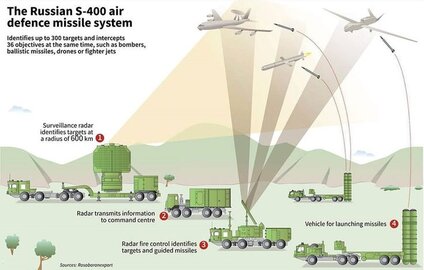
Why the S-400 Missile is Highly Effective — If Used Correctly Cont'd
The S-400 Triumph (known by NATO under the code name SA-21 Growler) is an anti-aircraft missile system that boasts a maximum range of 400 kilometers (250 miles) and can hit targets at an altitude of up to 27 kilometers. It was introduced in 2007. The system is mobile and includes the control hub and several missile launching elements, each of whom comprises of up to 12 launchers. The S-400 Triumph air defence system integrates a multifunction radar, autonomous detection and targeting systems, anti-aircraft missile systems, launchers, and command and control centre. It is capable of firing three types of missiles to create a layered defence.
The system can engage all types of aerial targets, including aircraft, unmanned aerial vehicles (UAV), and ballistic and cruise missiles, within the range of 400km at an altitude of up to 30km. The system can simultaneously engage 36 targets.
The system can engage all types of aerial targets, including aircraft, unmanned aerial vehicles (UAV), and ballistic and cruise missiles, within the range of 400km at an altitude of up to 30km. The system can simultaneously engage 36 targets.
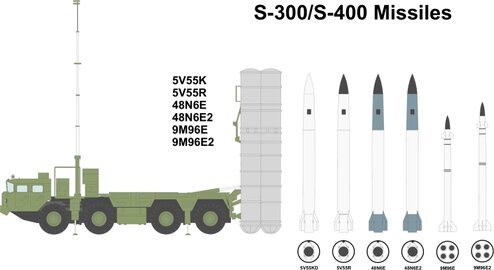
Why the S-400 Missile is Highly Effective — If Used Correctly Cont'd
The S-400 missile system uses four new missile types in addition to the missiles of the S-300PMU system. The first missile inducted for the system was the 48N6DM (48N6E3). It is an improved variant of the 48N6M with a powerful propulsion system. The missile can destroy airborne targets within the range of 250km. The 40N6 missile of the S-400 has a claimed range of 400km and uses active radar homing to intercept air targets at great distances. It can be launched against AWACS, J-STARS, EA-6B support jammers and other high-value targets. The S-400 Triumph also launches 9M96E and 9M96E2 medium range ground-to-air missiles. Designed for direct impact, the missiles can strike fast moving targets such as fighter aircraft with a high hit probability. The maximum range of the 9M96 missile is 120km.
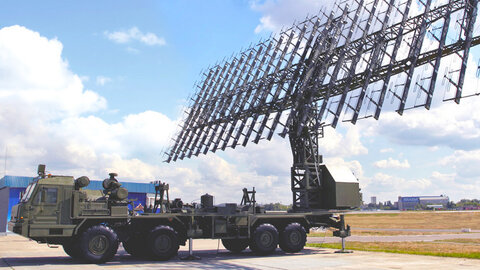
Nebo-M Radar Complex: The Stealth Buster. Multi-range radar station that tracks ballistic missiles, stealth planes & drones
Stealth technology is clearly the future of air combat.
In the future, as air defense systems grow more accurate and deadly, stealth technology can be a factor for a decisive by a country over the other. In the future, stealth technology will not only be incorporated in fighters and bombers but also in ships, helicopters, tanks and transport planes.
After stealth technology became quite effective, radar technology began to improve as well. New radar technology is currently being researched that will cause current stealth capabilities to become obsolete. It is well known that older short-wave radar technology used by Russia is able to detect stealthy aircraft considerably better than long-wave radar. Fortunately for stealth technology, all surface-to-air weaponry is based on long-wave radar so the systems cannot be combined to provide devastating results.
In the future, as air defense systems grow more accurate and deadly, stealth technology can be a factor for a decisive by a country over the other. In the future, stealth technology will not only be incorporated in fighters and bombers but also in ships, helicopters, tanks and transport planes.
After stealth technology became quite effective, radar technology began to improve as well. New radar technology is currently being researched that will cause current stealth capabilities to become obsolete. It is well known that older short-wave radar technology used by Russia is able to detect stealthy aircraft considerably better than long-wave radar. Fortunately for stealth technology, all surface-to-air weaponry is based on long-wave radar so the systems cannot be combined to provide devastating results.
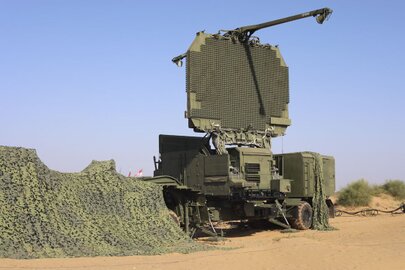
The Big Bird Target Aquisition and Battle Management Radar 91n6
The 91N6, also known as Big Bird, is a long-range air surveillance radar intended to provide target acquisition and battle management tracking the airborne threats. The radar system lies on a 12x12 high mobility articulated truck system and has a maximum detection range of 600 kilometers traking up to 300 airborne targets. The 91N6 radar system was developed by Almaz-Antey Concern as part of the S300, S350 and S-400 air defense system entering into service on April 28, 2007. Each S-400 battalion includes at least one 91N6 radar system.
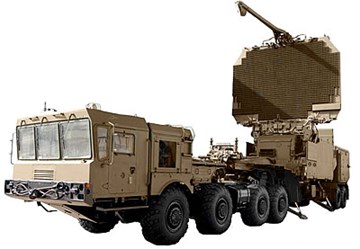
The Big Bird Target Aquisition and Battle Management Radar 91n6 Cont'd
The 91N6A, also known as 91N6M, is a target acquisition and battle management radar developed to support the S300, S350, S400 and S-500 air defense system. This air surveillance radar provides a battlefield picture at a distance in excess of 600 kilometers, most likely 800-to-1,000 kilometers, while tracking more than 300 objects simultaneously. The massive 91N6A radar complex is towed by a BAZ-6403 8x8 tractor. Known modifications:
91N6 - intended for maintenance with SA-10A “Grumble” (Russian designator: S-300) and SA-21 “Growler” (Russian designator: S-400 “Triumf”) SAM-systems, developed in 1978;
91N6A - modernized for use in S-400M “Triumf” SAM-systems, developed in the mid-80s;
91Н6М - modernized for future use in S-500 “Prometheus” SAM-systems (maximum range: 640 km);
91N6E - variant for export, without the Russian IFF and possibly reduced combat characteristics.
91N6 - intended for maintenance with SA-10A “Grumble” (Russian designator: S-300) and SA-21 “Growler” (Russian designator: S-400 “Triumf”) SAM-systems, developed in 1978;
91N6A - modernized for use in S-400M “Triumf” SAM-systems, developed in the mid-80s;
91Н6М - modernized for future use in S-500 “Prometheus” SAM-systems (maximum range: 640 km);
91N6E - variant for export, without the Russian IFF and possibly reduced combat characteristics.
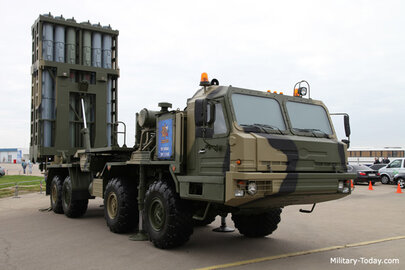
S-350 Vityaz - Medium-range air defense missile system (Russia's upgrade modern solution for S125 & s300PS replacement)
The S-350 Vityaz (knight) is a short-to-mid range air defense missile system. It was developed by Almaz-Antey company as a replacement for the ageing S-300PS, which was developed back in the early 1980s, and Buk M1-2 system, which is now over 20 years old. Development commenced in 2007. The S-350 was first demonstrated in 2013. It was planned that production of this air defense system will commence in 2015, however by 2017 this system was still tested. First S-350 air defense systems were reportedly delivered to the Russian military in 2019. Design of this air defense system is broadly similar to the South Korean KM-SAM Chun Koong. It is worth noting that Almaz-Antey participated in development of this South Korean SAM system. It is claimed that the S-350 Vityaz is more capable than the South Korean system.
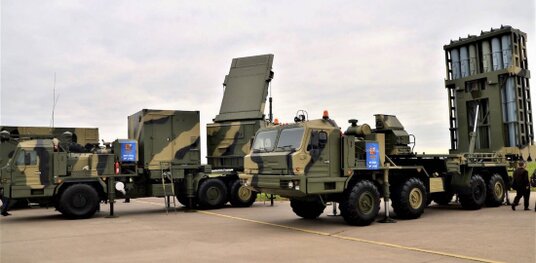
S-350 Vityaz - Medium-range air defense missile system (Russia's upgrade modern solution for S125 & s300PS replacement) Cont'd
It entered service with the Russian armed forces in 2016. At this stage Russian MoD bought more than 100 of these SAM systems in order to replace older variants of the S-300PS and Buk M1-2 systems. Russians plans to scrap about 50 of the S-300PS systems by 2015 due to their age. The Vityaz TEL vehicle carries a total of 12 9M96 vertically-launched missiles. The same medium-range missiles are used by the recent Russian S-400 air defense system. The 9M96 is a variant of the 9M96 active radar-homing interceptor missile. This missile is designed for direct impact. It is similar to the US Patriot PAC-3 design and is intended to provide point defense against precision attacks and defense suppression weapons. Its claimed kill probability is 90% against aircraft and 70% against Harpoon anti-ship missile. The S-350 can also launch a short-range missile which is likely a variant of the 9M100. This air defense system can engage targets within ranges from 30 to 120 km.

S-350 Vityaz - Medium-range air defense missile system (Russia's upgrade modern solution for S125 & s300PS replacement) Cont'd
The S-350 system also has advanced phased-array radar and a new mobile command post. If required a number of vehicles can be linked together to form a battery. A typical battery consists of command post can, two radars and control 8 TEL vehicles. Vityaz SAM system can operate autonomously or alongside other air defense systems. It can stop and launch its missiles within 5 minutes from traveling. This air defense system can engage 12 to 16 targets simultaneously, including aircraft and ballistic missiles. Command post can target up to 32 missiles on various targets at once. The TEL vehicle has a crew of three. It is based on a BAZ-6909 special wheeled chassis with 8x8 configuration. Radar and command post are carried by BAZ-69092 with 6x6 configuration
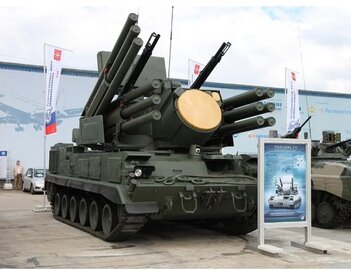
PANTSIR-S1 / PANTSYR-S1 / SA-22 GREYHOUND - Short range mobile air defense cannons/missiles system - Russia
The Pantsir-S1 (SA-22 Greyhound NATO code name) is an air defense missile-gun system designed to protect vital small-size and big military areas, industrial targets and land forces units and reinforced the air defense units responsible for the protection of troops and military installations against precision-guided air attack from low and extremely low altitudes. The mobile version of the Pantsir-S1 system includes a combat vehicle ( up to six vehicles in a battery), surface-to-air guided missiles, 30 mm rounds, a transporter-loader vehicle (one per two combat vehicles), maintenance and training facilities.

PANTSIR-S1 / PANTSYR-S1 / SA-22 GREYHOUND - Short range mobile air defense cannons/missiles system Cont'd
The armament of Pantsir-S1 consists of twelve 57E6 surface-to-air guided missiles and two 2A38M30-millimetre automatic guns developed from the two-barreled 30mm GSh-30 gun. It is provided with a multi-range radar capable of detecting aerial targets with an effective surface of dispersion of up to 2-3 square meters at a distance of more than 30 kilometers and tracking them down from a distance of over 24 kilometers. With its missiles, the Pantsir-S1 can engage tactical aircraft at a maximum range of 20 km and altitude of 10 km, subsonic cruise missiles at a range of 12 km and altitude of 6 km, and high-speed air-to-ground missiles at a range of 7 km and altitude of 6 km. With its gun weapons, the Pantsir-S1 can destroy aerial targets at a maximum range of 4 km and a maximum altitude of 3 km.
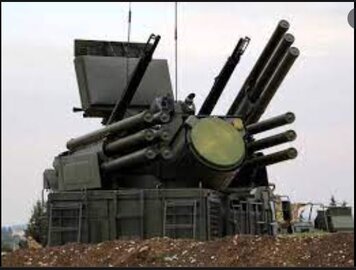
PANTSIR-S1 / PANTSYR-S1 / SA-22 GREYHOUND - Short range mobile air defense cannons/missiles system Cont'd
he Pantsir S-1 can conduct fire at two targets at the same time and attack up to 12 targets within a minute. The system's effective range for missiles is 20 kilometers and the maximum altitude is eight kilometers, and for artillery shells up to three and four kilometers respectively. It can also operate in a passive mode using an infrared channel in the long-wave band with logical processing of the signal and automatic tracking. The Pantsir-S1 is able to defeat almost the entire spectrum of air threats, all types of precision-guided weapons, in particular, flying at a speed of up to 1,000 m/s and approaching from different bearings at an angle of 0- 10 ° to 60 - 70°, aircraft flying at a speed of up to 500 m/s, helicopters, remotely piloted vehicles, as well as light armored ground targets and the enemy manpower. The combination of missile and gun armament enables the operator to create a continuous target engagement zone and fire at targets uninterruptedly beginning from their maximum range of 18 to 20 km up to a range of a minimum of 200 m. Target flying at an altitude of 5 to 15 km can be shot down. The Pantsir-S1 is equipped with a multiple-mode adaptive radar/optical weapons control system operating in the UHF, EHF, and IR regions of the spectrum. The system features high immunity to jamming, survivability in the presence of electronic countermeasures and under enemy fire.
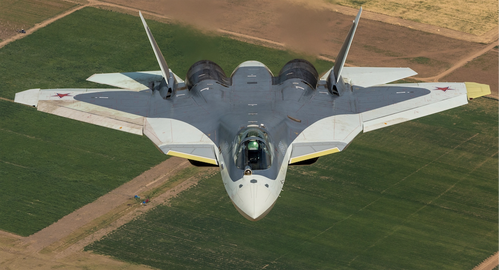
Six Features We like On Russia's New Stealth Fighter - No, The Su-57 Isn't 'Junk:'
The aircraft’s degree of low-observability (stealthiness) has long been in question, as it lacked many of the key features that define modern stealth fighters. But none of this conclusively means the Su-57 doesn’t have some redeemable qualities and features that are worth pointing out.
Sukhoi designers have taken a 'balanced' approach to low-observability, whereby the aircraft's reduced radar signature from certain aspects becomes just another feature to be weighed against other design priorities. This very well may have been a necessity due to lack of stealthy materials science, manufacturing, and design expertise, but none-the-less the outcome is the same.
And considering how Russia's armed forces are organized and the battle doctrine behind that organization, being able to pierce deep into the most sophisticated integrated air defense networks during some sort of expeditionary operation isn't a top priority anyway.
Sukhoi designers have taken a 'balanced' approach to low-observability, whereby the aircraft's reduced radar signature from certain aspects becomes just another feature to be weighed against other design priorities. This very well may have been a necessity due to lack of stealthy materials science, manufacturing, and design expertise, but none-the-less the outcome is the same.
And considering how Russia's armed forces are organized and the battle doctrine behind that organization, being able to pierce deep into the most sophisticated integrated air defense networks during some sort of expeditionary operation isn't a top priority anyway.
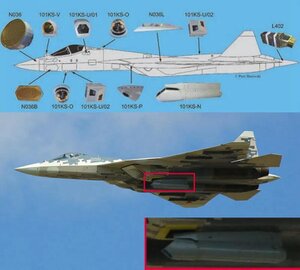
Six Features We like On Russia's New Stealth Fighter - No, The Su-57 Isn't 'Junk:' CONT'D
But once again, stealth is just one ingredient of a complex cocktail that makes up an advanced fighter's overall capabilities set and ability to survive in various combat situations.
With all this in mind, here are five features we like on the Su-57, some of which are tailored to help overcome its lack of extreme signature reduction, at least to a certain degree.
1. Side Facing Cheek-Mounted Radars with Long Range nose-mounted X-Band N036 Byelka (Squirrel) AESA radar system.
2. 101KS 'Atoll'Infrared Search and Track with Multiple Sensors Electronic Warfare Terminals/Devices.
3. All Round Cover for Directional Infrared Countermeasures System.
4. Austere Airfields Welcome & Short Takeoff & drogue parachutes before touching the ground.
5. 3D Thrust Vectoring with Super LEVCONS (leading–edge vortex controllers) near the cockpit.
6. Unique Weapons Bay Configuration with 12 Hard Points (06 Internal & 06 External).
With all this in mind, here are five features we like on the Su-57, some of which are tailored to help overcome its lack of extreme signature reduction, at least to a certain degree.
1. Side Facing Cheek-Mounted Radars with Long Range nose-mounted X-Band N036 Byelka (Squirrel) AESA radar system.
2. 101KS 'Atoll'Infrared Search and Track with Multiple Sensors Electronic Warfare Terminals/Devices.
3. All Round Cover for Directional Infrared Countermeasures System.
4. Austere Airfields Welcome & Short Takeoff & drogue parachutes before touching the ground.
5. 3D Thrust Vectoring with Super LEVCONS (leading–edge vortex controllers) near the cockpit.
6. Unique Weapons Bay Configuration with 12 Hard Points (06 Internal & 06 External).
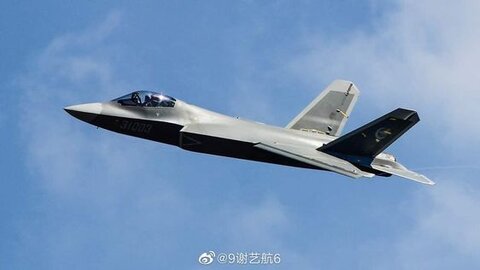
China Offers FC-31 Stealth Fighter At Half the Price of US F-35
China launched the global marketing of its FC-31 stealth fighter jet that costs about US$70 million, about half the price of the Lockheed Martin F-35, at Paris Air Show 2017.
"We expect that the plane's price will be around $70 million, about half that of the Lockheed Martin F-35 Lightning II from the US, which is the only fifth-generation fighter jet available on the market from the US, which only sells it to allies." Fu Qianshao, an aircraft expert with the PLA Air Force was quoted as saying by China Daily Tuesday.
Aviation Industry Corporation of China (AVIC) has displayed a model of the FC-31 on display at the 52nd International Paris Air Show, held at at Paris-Le Bourget Airport.
China decided to tap the well-advanced countries’ military aircraft market with the domestically developed FC-31 stealth fighter jet, the plane's chief designer Lin Peng of AVIC's subsidiary Shenyang Aircraft Design and Research Institute said.
"We expect that the plane's price will be around $70 million, about half that of the Lockheed Martin F-35 Lightning II from the US, which is the only fifth-generation fighter jet available on the market from the US, which only sells it to allies." Fu Qianshao, an aircraft expert with the PLA Air Force was quoted as saying by China Daily Tuesday.
Aviation Industry Corporation of China (AVIC) has displayed a model of the FC-31 on display at the 52nd International Paris Air Show, held at at Paris-Le Bourget Airport.
China decided to tap the well-advanced countries’ military aircraft market with the domestically developed FC-31 stealth fighter jet, the plane's chief designer Lin Peng of AVIC's subsidiary Shenyang Aircraft Design and Research Institute said.
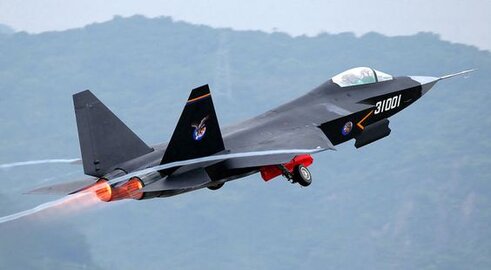
China Offers FC-31 Stealth Fighter At Half the Price of US F-35
“The FC-31 has received a lot of attention from potential foreign buyers.” he said Monday. This has been the first time the aircraft firm brought its latest stealth fighter jet to a Western air show and the second time for the FC-31 to be shown at a foreign exhibition. The first was at the 14th Dubai Airshow in the United Arab Emirates in November 2015.
"We will strive to use the fifth-generation combat plane to seize some share in the military aircraft market of developed nations," Lin said. FC-31's appearance in Paris is intended to showoff China's capabilities in the research and development of advanced military aircraft. The intention is to enable major buyers to know more about the plane so they can communicate "in-depth" with AVIC about the fighter jet,
Though the FC-31 is not yet in production, the firm believes that the external features of the plane is likely to generate interest that could lead to sales. The air show is also a suitable occasion for the Chinese stealth fighter jet to compete with its counterparts, the designer added.
"We will strive to use the fifth-generation combat plane to seize some share in the military aircraft market of developed nations," Lin said. FC-31's appearance in Paris is intended to showoff China's capabilities in the research and development of advanced military aircraft. The intention is to enable major buyers to know more about the plane so they can communicate "in-depth" with AVIC about the fighter jet,
Though the FC-31 is not yet in production, the firm believes that the external features of the plane is likely to generate interest that could lead to sales. The air show is also a suitable occasion for the Chinese stealth fighter jet to compete with its counterparts, the designer added.
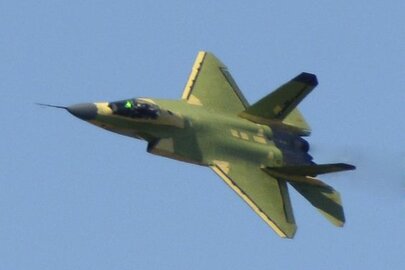
China Offers FC-31 Stealth Fighter At Half the Price of US F-35
The FC-31 was unveiled in October 2012 as a twin-engine, radar-evading fighter jet. At that time, the first prototype had made its maiden flight, becoming the country's second fifth-generation fighter jet following the J-20, which made its first flight in January 2011. The People's Liberation Army Air Force has begun to receive deliveries of the J-20.
Lin said the FC-31 features high survivability, a low radar signature, supreme electronic countermeasures, high information capacity, situation awareness and beyond-visual-range combat capability. The aircraft has a large weapon bay and several external hard points that are capable of carrying Chinese-or foreign-made air-to-air missiles and air-to-surface weapons, he said.
Specifications from AVIC show the FC-31 has a maximum takeoff weight of 25 metric tons, a combat range of 1,200 km and a top speed of Mach 1.8, or 2,205 kilometers per hour. It can carry 8 metric tons of weapons and has a designed service life of up to 30 years. Li Yuhai, deputy general manager of AVIC, said earlier that AVIC plans to use the FC-31 to "put an end to some nations' monopolies on the fifth-generation fighter jet" and this plane "is able to compete with any other aircraft of its kind".
Lin said the FC-31 features high survivability, a low radar signature, supreme electronic countermeasures, high information capacity, situation awareness and beyond-visual-range combat capability. The aircraft has a large weapon bay and several external hard points that are capable of carrying Chinese-or foreign-made air-to-air missiles and air-to-surface weapons, he said.
Specifications from AVIC show the FC-31 has a maximum takeoff weight of 25 metric tons, a combat range of 1,200 km and a top speed of Mach 1.8, or 2,205 kilometers per hour. It can carry 8 metric tons of weapons and has a designed service life of up to 30 years. Li Yuhai, deputy general manager of AVIC, said earlier that AVIC plans to use the FC-31 to "put an end to some nations' monopolies on the fifth-generation fighter jet" and this plane "is able to compete with any other aircraft of its kind".
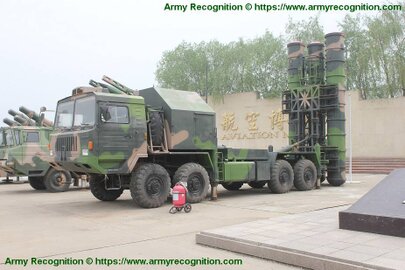
Hong Qi 9 (HQ-9) Air Defence Missile System - Medium-to-Long range active radar homing surface-to-air missile from China
The HQ-9 is a medium-to-long range air defense missile system designed and manufactured in China by the Defense Company CPMIEC (China Precision Machinery Import & Export Corporation). The HQ-9 system is designed to track and destroy aircraft, cruise missiles, air-to-surface missiles, and tactical ballistic missiles. The system was unveiled for the first time to the public during the military parade for the 60th anniversary of the founding of the People's Republic of China. The HongQi 9 development began in the early 1980s, initially based on the U.S. Patriot air defense missile system that China obtained via an unknown third-party country. Like the Patriot, the HongQi 9 uses a ‘Track-Via-Missile’ (TVM) terminal guidance system and was originally designed to be launched from a Patriot-style slant-positioned box-shape container launcher. Turkey could be interested to buy FD-2000, the export version of HQ-9.
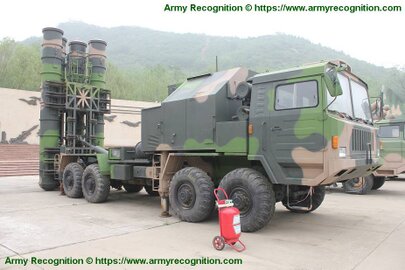
HQ-9 air defense missile system variants:
- FD-2000: export version of HQ-9 with Anti stealth capabilities.
- FT-2000: with a passive homing-all-the-way variant of the HQF-91 LR-SAM, which operates in conjunction with a ground-based DWL-002 passive surveillance system (PSS), which has been developed by CETC International Co Ltd.
- HHQ9: naval version
- HQ-9A: Upgraded version, first tested in 1999 and service entry in 2001.
- HQ-9B: with extra range and dual seeker.
- HQ-9C: Currently under development, incorporating active radar homing mode
- FT-2000: with a passive homing-all-the-way variant of the HQF-91 LR-SAM, which operates in conjunction with a ground-based DWL-002 passive surveillance system (PSS), which has been developed by CETC International Co Ltd.
- HHQ9: naval version
- HQ-9A: Upgraded version, first tested in 1999 and service entry in 2001.
- HQ-9B: with extra range and dual seeker.
- HQ-9C: Currently under development, incorporating active radar homing mode
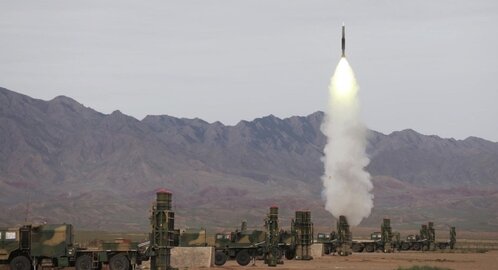
HQ-9 air defense missile system Armament, Design and protection, Mobility
The launcher erector truck (TEL) has four missile containers. In firing position, the missiles containers are placed at the vertical to the rear side of the truck, two stabilizers are deployed at the rear and center of the chassis. The HongQi 9 (HQ-9) is a two-stage missile. The first stage has a diameter of 700 mm and the 2nd stage 560 mm, with a total mass of almost 2 tons and a length of 6.8m. The missile is armed with a 180 kg warhead, has a maximum speed of Mach 4.2. and has a maximum range of 200 km up to an altitude of 30 km. The missile has a proximity fuse with an effective range of 35m, which goes active when the missile is 5km away from its target. The thrust vector control (TVC) of HQ-9 is the most obvious visual identification that distinguishes it from S300V: TVC of HQ-9 is exposed and thus can be observed from the side, while TVC of S300V is not exposed. The HQ-9's guidance system is composed of inertial guidance plus mid-course uplink and active radar terminal guidance systems. The missile containers are mounted on a Chinese Taian TAS-5380 8x8 truck chassis which is based on the Russian truck the MAZ-543. The TAS-5380 is powered by an air-cooled diesel engine.
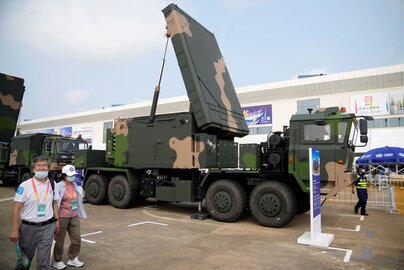
HQ-9 air defense missile system Accessories
A battery of HQ-9 consists of 6 TEL trucks linked to an HT-233 3D C-band mono-pulse planar phased array radar, under the control of a TWS-312 battery command post. The HT-233 engagement radar has always been regarded to be a derivative of the Russian 30N6E Flap Lid / Tomb Stone series, sharing most of the basic technology in this design. It operates in the 300 MHz bandwidth and has a detection range of 120 km and a tracking range of 90 km. The radar can detect targets in azimuth (360 degrees) and elevation (0 to 65 degrees), and is capable of tracking some 100 airborne targets and simultaneously engaging more than 50 targets. Several search radars can be used with HQ-9, including anti-ballistic radars and anti-stealth radars, as the search radar Type 305B, the low altitude radar Type 120, the search radar Type 305A, the passive radar YLC-20 and the passive radar DWL002.
In the Chinese Armed Forces, an HQ-9 battery includes a command vehicle, six control vehicles, 6 targeting radar vehicles, 6 search-radar vehicles, 48 missile-launch vehicles, and 192 missiles; plus a positioning vehicle, a communications vehicle, a power supply vehicle and a support vehicle. A battalion reportedly contains 8 missile launch vehicles.
In the Chinese Armed Forces, an HQ-9 battery includes a command vehicle, six control vehicles, 6 targeting radar vehicles, 6 search-radar vehicles, 48 missile-launch vehicles, and 192 missiles; plus a positioning vehicle, a communications vehicle, a power supply vehicle and a support vehicle. A battalion reportedly contains 8 missile launch vehicles.
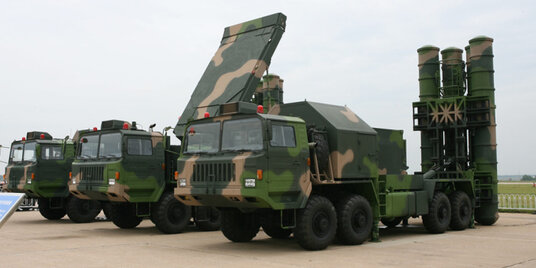
HQ-9 air defense missile system Radar and Guidance system
The battery includes Type 120 low-altitude acquisition radar, Type 305A 3D acquisition radar, H-200 mobile engagement radar, and Type 305B 3D acquisition radar. The HT-233 radar operates in the 300MHz bandwidth with a target detection range of 120km and a tracking range of 90km. It can scan 360° in azimuth at an elevation range from 0° to 65°. The radar is designed to track 100 airborne targets and simultaneously engage more than 50 of them at a distance of approximately 100km. The track-via-missile (TVM) guidance system of HQ-9 employs a combination of inertial guidance, mid-course uplink, and active radar terminal guidance systems. Some of the missile variants have an optional semi-active radar homing capability with radio command guidance.
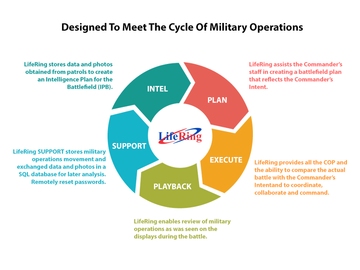
LifeRing works as a scalable C4I Common Operational Picture (COP) System used by Military & Intelligence Agencies.
LifeRing can be adjusted to display differing types of symbology, different types of maps, different coordinate systems and differing operator controls yet remain compatible with other LifeRing Network Participants. Thus, in a joint Military/First Responder operation, the Military can be using Mil-STD 2525 symbology and Military Grid Reference System with measurements in Kilometers, while First Responders are using a different type of symbology and Latitude / Longitude with measurement in miles. Both can exchange properly geo-referenced data. Furthermore, some of the devices may be displaying in North up while others are displaying in Heading up or operating in either a Portrait or Landscape mode.
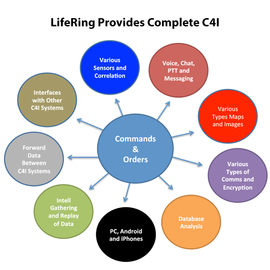
LifeRing works as a scalable C4I Common Operational Picture (COP) System used by Military & Intelligence Agencies Cont'd
The LifeRing Server processes over 80 map, Satellite, and Aerial photograph formats. All maps are geo-referenced and can be stitched into other maps. Maps can be loaded into memory, loaded on an SD Card, and obtained from: LifeRing Servers, web map servers, commercial sources and military sources (GeoPDF, NITF, CIB, et al)
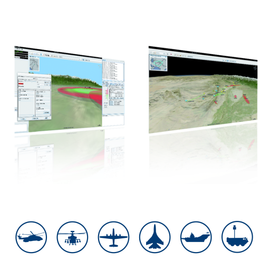
LOKI COMMAND & CONTROL - INFORMATION TECHNOLOGY OPERATIONS
Loki is the first Italian C&C for net-centric Electronic Warfare and multi-platform coordination that implements a System of Systems integration in IT OPS. (IT OPS)
Loki is Elt’s capability for:
Managing complex of the EW missions: coordinating and integrating heterogeneous intelligence sources and operative cells (sensors and actuators; both Elt and 3rd party)
Achieving situational awareness of own and blue force assets
Controlling resources assigned to the Commander and dispatching orders to other levels of command
Loki is Elt’s capability for:
Managing complex of the EW missions: coordinating and integrating heterogeneous intelligence sources and operative cells (sensors and actuators; both Elt and 3rd party)
Achieving situational awareness of own and blue force assets
Controlling resources assigned to the Commander and dispatching orders to other levels of command
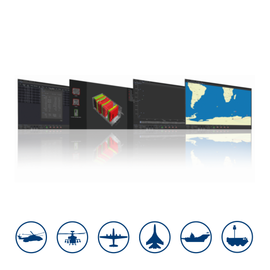
The ELT 950 a.k.a. EW Manager (EWM)
ELT 950 a.k.a. EW Manager (EWM) is Elt’s C&C system designed as Combat Management Systems for Electronic Warfare assets. It enables the integration of many Sensors and Actuators (both Elt and 3rd party) installed onto the same platform.
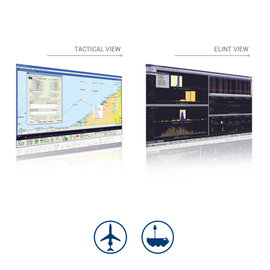
ELT/819 ELINT SYSTEM
The ELT/819 family is the latest generation of Elettronica’s ELINT and Surveillance systems; its modular architecture can be configured to comply with customer requirements. The system can accommodate, in addition to the ELINT functionalities, the COMINT/CESM capabilities. ELT/819 performs both Tactical Surveillance (ESM and Tactical ELINT functions) with Warning and Self Protection capability (High POI) and highly accurate data analysis for Intelligence (Technical ELINT function).
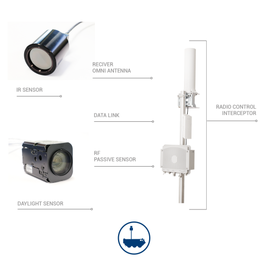
ADRIAN (Anti-Drone Interception Acquisition Neutralization)
ADRIAN (Anti-Drone Interception Acquisition Neutralization) is the state of art Counter-UAV solution designed to Intercept and Neutralize LSS (Low-Small-Slow) UAV in multiple scenarios and environments, including urban and dense-urban environment.
Traditional sensors and countermeasures may be not effective or not applicable in urban warfare. Therefore ADRIAN is based on multispectral sensors (Radar, EO/IR, acoustic and radio link interceptor) performing data fusion for detection and identification. ADRIAN architecture is modular and can be tailored depending on operational, environmental and cost/effectiveness requirements.
High sensitivity and high efficiency receivers enable LSS platforms detection, while the data fusion algorithm in the mission planner station provides a high Probability of Intercept, low false alarm rate and a comprehensive Situational Awareness with the reaction management tool. ADRIAN reactive and smart jammer is capable to deny the remote control link of the platform and the navigation aids signals used to follow the programmed route through proper waypoints. Innovative jamming techniques enhancing the effectiveness of soft kill disruption of hostile platforms maintaining full operational services of active friendly platforms.
Traditional sensors and countermeasures may be not effective or not applicable in urban warfare. Therefore ADRIAN is based on multispectral sensors (Radar, EO/IR, acoustic and radio link interceptor) performing data fusion for detection and identification. ADRIAN architecture is modular and can be tailored depending on operational, environmental and cost/effectiveness requirements.
High sensitivity and high efficiency receivers enable LSS platforms detection, while the data fusion algorithm in the mission planner station provides a high Probability of Intercept, low false alarm rate and a comprehensive Situational Awareness with the reaction management tool. ADRIAN reactive and smart jammer is capable to deny the remote control link of the platform and the navigation aids signals used to follow the programmed route through proper waypoints. Innovative jamming techniques enhancing the effectiveness of soft kill disruption of hostile platforms maintaining full operational services of active friendly platforms.
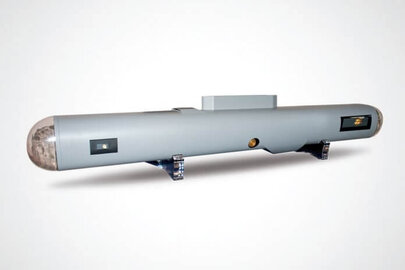
EDGE ESCORT/SUPPORT JAMMER POD
While standard combat aircraft Integrated Self-Defence Systems (ISDSs) provide protection for individual planes, EW pods can detect and jam radar threats for several. This is important when flying in contested airspace where several aircraft in a strike package may have ISDSs of varying competence. A pod helps support tactical electromagnetic superiority and supremacy. With threats to airpower proliferating like Russia’s oft-cited Almaz-Antey S-400 (NATO reporting name SA-21 Growler) high-altitude/long-range Surface-to-Air Missile (SAM) system, there is an ever-present need to ensure that packages of aircraft are as well protected as possible when flying through dangerous airspace.
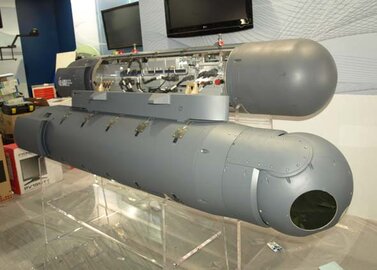
IAI/Elta has unveiles TASCAN targeting pod
IAI/Elta has unveiled the TASCAN Electro-Optical targeting pod for fighter aircraft, thereby complementing its EL/M-20600 Radar Targeting Pod (RTP) which uses Synthetic Aperture Radar (SAR) for that purpose. Sofar Elta’s RTP has been offered along with the Litening EO targeting pod produced by Israel’s Rafael Advanced Defense Systems. IAI’s pursuit of an independent program could mark a departure from this cooperation. The TASCAN is slightly longer, compared to the Litening, comprising the new EO outfit provided by IAI/Tamam. According to IAI sources, the new targeting pod employs the latest in EO/IR technology, and uses a gimbaled platform carrying the EO sensors. The TASCAN sibling, RTP comprises SAR/MTI radar design, relying on a radar transceiver operating in the Ku Band. Inter-pod cooperation is possible, in which for wide area search, the RTP is employed in either SAR or Moving Target Indicator (MTI) mode, and as potential targets are spotted, the RTP queues the EO pod for investigation and target acquisition. The SAR can also provide targeting data under no-visibility conditions.


